- Privacy Policy
- Conservation
- Fly Shop Tour
- Video of the Week
- F3T Behind the Lens
- Destination Video of the Week
- Faces of Fly Fishing
- Photographer Spotlight
- Costa Behind The Guides
- Organization of the Month
- Artist Spotlight


Fishing Trip Checklist: How To Put Together An Incredible Experience

“By failing to prepare, you are preparing to fail”, sure, Ben Franklin may not have been talking about your next fly fishing trip, but a little preparation sure goes a long way. Having a fishing trip checklist that you can rely on time and time again will help cut down the amount of time you spend preparing. Last minute or late night packing has cost me on more than one fishing trip. This complete Fishing Trip Checklist will help ensure you don’t forget any of the essentials as you prepare to hit the water on your next fly fishing trip.
Why is it so important to prepare for a fishing trip?
About a year ago I was on a camping and fishing trip with my partner Nikki in Southwest Colorado. Our plan for one particular day was to hike to a high alpine lake and fish for wild cutthroat trout. Sounds great, right? Everything was going smoothly until we arrived at our destination after a grueling hike when I discovered that I had forgotten my reel. As a result, I got to spend my afternoon watching fish snatch dry fly after dry fly off the surface with my hands in my pockets. Not the worst thing in the world, but it sure would have been more fun to land a few.

Moral of the story, taking time to consider all of your equipment needs from the fishing basics (i.e. rod and reel) to clothing is crucial for maximizing your time on the water. Having a reliable fishing trip checklist will help ensure that you don’t forget any of your fishing essentials before hitting the road. If I have space in my car, I’ll try to take some of the stuff that “I’ll never need” like spare hats, sunglasses, extra layers, shoelaces, old wading boots, and more, however, the following fishing trip checklist covers all the necessities so hopefully, you don’t need the spares!
Key Considerations for any Fishing Trip
There are a few key things to keep in mind while planning your next fishing trip. The first and arguably most important would be the weather. Having spare layers is crucial in winter months but being prepared with a rain jacket can save the day in the shoulder months. I’ve left home more than once without checking the weather and ended up cutting my day short due to cold ears and fingers. Checking forecasts and knowing seasonal weather patterns for the area that you plan to fish can make or break your day.

Another key consideration would be the species that you plan to target. If you are planning a multi-species trip, a variety of rods, reels, and fly boxes may be required. Researching the location you plan to fish and types of water (streams, rivers, lakes) can help ensure you don’t leave that perfect fly box at home. On a multi-day trip, taking your vice and fly tying materials along with you is a surefire way to ensure you can match the hatch or even restock your magic patterns streamside.
Other activities you may be doing such as camping, hiking, and the length of your fishing trip will obviously change the amount of gear that you need but our fishing trip checklist will help ensure your bases are covered.
The Fishing Trip Checklist
This comprehensive Fishing Trip Checklist will help make sure you have all the essentials for a day on the water chasing your favorite species.

Download the Flylords Fishing Trip Checklist here.
Article by Evan Garda, he is on the Content Team here at Fly Lords. He can be found chasing trout throughout the west with his trusty fly rod. Check out his adventures at @evangarda .
Join Our Weekly Newsletter:
Backcountry Fly Fishing Gear Guide
Get Wet: A Guide to Wet Wading
RELATED ARTICLES MORE FROM AUTHOR
Fishing tips: fly fishing during high water, tools of the trade: fishing streamers with george daniel, coors banquet x ross reel now available.
Very handy checklist! I’m new to your site but will surely be visiting often! Cheers!
I’m a fan of fly fishing, but didn’t know I needed this checklist so badly. Also, I very much love how you categorize the essentials according to clothing, gear, etc. Very helpful
Thanks for the reminder that it’s important to also have a good jacket when going on a fly fishing trip. I plan to take my nephew to one soon because I’m thinking about bonding with him more often in the future. I think that will be a good idea since I haven’t really spent time with him in years.
LEAVE A REPLY Cancel reply
Save my name, email, and website in this browser for the next time I comment.
Notify me of follow-up comments by email.
Notify me of new posts by email.
This site uses Akismet to reduce spam. Learn how your comment data is processed .
Enjoy The Wild
Outdoor activities/ Adventure/ Survival/ Travel Blog
Fishing Trip Packing List: What To Bring on a Fishing Trip
Last Updated on 08/23/2022 by Brian John
Are you packing for your next big fishing trip ? Go through this fishing trip packing list to make sure you don’t forget anything important! Whether you’re a beginner to fishing or an old pro, everyone forgets something they need sometimes. Stay on top of your packing game and be prepared as possible when you get out on the water.

What To Pack for a Fishing Trip
Make sure you have this essential fishing gear packed for your fishing trip. Depending on where you’re going fishing and what type of fishing you plan to do, you may need more than this, but these are the basics:
Fishing License
Fishing rod, reel, and line, fishing hat, sunglasses, and sunscreen, first aid kit, fishing cart, caddy, or backpack, other tools.
Most states require you to have a fishing license to legally catch fish. Each state, and often each body of water, also has different regulations about where you can fish, what you can catch, and catch-and-release guidelines. Check out your state fishing laws and research your specific fishing location to ensure that you follow all laws and local regulations.
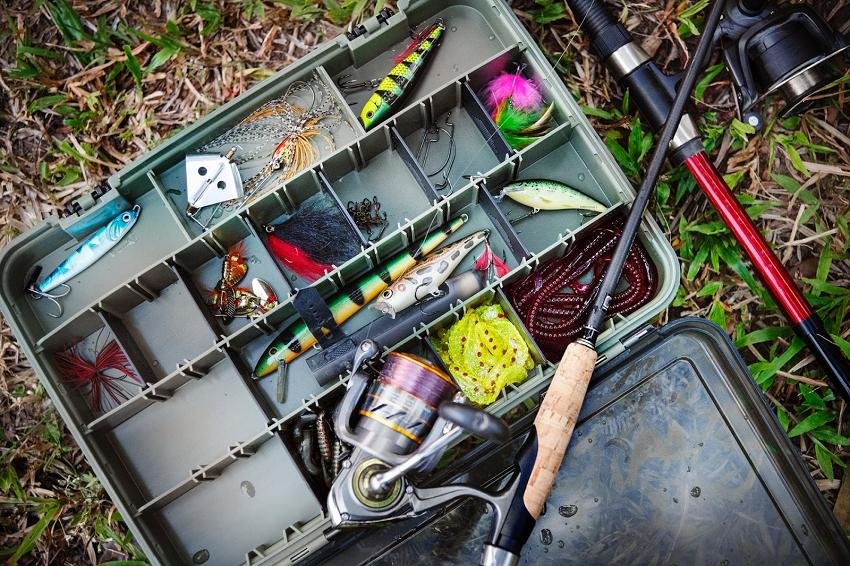
You can’t catch fish without a fishing rod, reel, and fishing line! These are the most basic staples you’ll need to go fishing. Fishing rods come in various sizes and have different features that may affect your choice - research the best rods for your style of fishing before you make a purchase.
There are also different types of reels to choose from. The most popular and easy to use fishing reel is a spinning reel, but more experienced anglers often choose a baitcasting reel, or a fly reel for fly fishing.
Fishing line is essential to use your rod and reel and to catch fish. There are three main kinds: monofilament, braided, and fluorocarbon. Your choice of line depends on your rod and reel, where you’re fishing, and what you plan to catch. You’ll also need extra, special line called leaders that you tie to the end of the line and attach tackle to.
You can’t forget to pack tackle if you plan to catch anything. Tackle is the equipment that is attached to the end of your line. The basic tackle you should have on your checklist includes bait, lures, hooks, swivels, bobbers, and weights. Your choice of live bait or artificial lures will depend on where you’re fishing and what you hope to catch. Research beforehand, or ask for help at the local tackle shop the day of.

Now that the weather has warmed up and the sun is out, fishermen need to be careful about the harmful effects of the sun on their skin. Be sure to pack a fishing hat to protect your face and neck , sunglasses to protect your eyes and help you see out on the water, and sunscreen (SPF 30 at least). Long hours out on the water can cause serious damage, so don’t forget to pack these.
Every fishing trip checklist should include a first aid kit! Ideally, you won’t have to use this, but it’s better to be safe than sorry. Out on the water, you may not have immediate access to medical care, and handling sharp hooks and tools can cause injuries. Be sure to pack a first aid kit with the basics and any other medications you may need.

A cooler may not be the first piece of fishing equipment that comes to mind, but you’ll likely need one for a few reasons. First, you should always pack water when you’re out fishing so that you stay hydrated. Why not keep your water cold all day in a cooler? Another reason you may need a cooler is if you use live bait - you’ll want to keep the bait cool and alive for as long as possible to improve your chances of a catch. Finally, when you do catch something, you’ll need to keep the fish on ice so that it doesn’t spoil.
You’ll need something to help carry all of this gear. Depending on where you’re fishing, you can opt for fishing carts, caddies, or simply a waterproof backpack and tackle boxes. If you’re going surf fishing, choose from some of the best surf fishing carts to travel over sand and surf. A caddy is easier for carrying less equipment, either on a beach, pier, or simply to the boat.
There are a few other basic tools you’ll need to go fishing. Scissors or a knife are necessary to cut line, and a knife is also useful if you want to start gutting or filleting your fish. Needle-nose pliers are needed to take hooks out of fish - you can use your hands, but you might cut yourself on the hook or the fish’s teeth. These three items may come all together in a multi-tool or Swiss army knife. Other tools that are optional but can be helpful are a scale to weigh your catch, and a tape measure to measure its length.

Pack for Your Next Fishing Trip
Now that you have a checklist of the essential fishing gear you need to pack for your next trip, you can begin prepping for a day out on the water. Don’t forget the gear on this packing list, and anything more specific you may need.
Sharing is caring!
Book Your Next Florida Fishing Charter Adventure Today - 321-652-5903

What to Bring Charter Fishing: The Ultimate Checklist
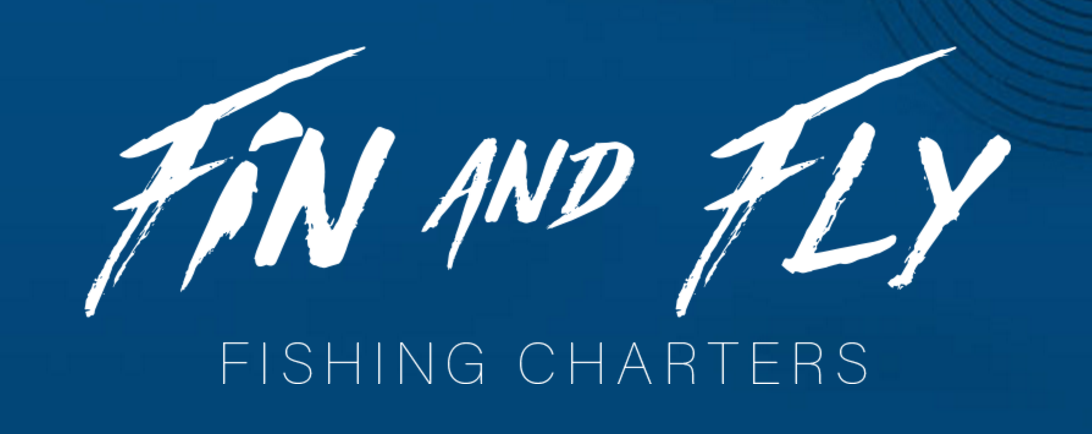
June 21, 2018
You’ve been traveling all day, but you’ve finally made it. You’re in beautiful, sunny Florida and it’s vacation time! Your days here are action-packed, but the one thing you’re looking forward to most is heading out into the open ocean off Cape Canaveral with a professional, experienced deep sea fishing charter. There’s only one problem. You have no idea what to pack!
Don’t panic! Whether you’re experienced or need some deep sea fishing tips for beginners, here’s Fin and Fly’s ultimate deep sea fishing guide to what you should bring along.
Clothing: What to Wear Deep Sea Fishing
When heading out onto Florida’s beautiful Space Coast, the most important thing to remember is that the weather may change. The Sunshine State lives up to its name, but it pays to be prepared! You want to make sure you’ll be comfortable when hauling in your catch.
- Rain gear or windbreaker. These are essential for protecting you from anything from downpours to sea spray! Both will keep you warm if you find yourself a little chilly in the early morning.
- Light clothing. Shorts, a t-shirt, or a light long sleeve shirt will keep you cool under the Florida sun.
- Hat. This will help keep your head cool and the sun out of your eyes.
- Polarized sunglasses. These are a must! Polarized sunglasses protect your eyes from the glare off the water. All the better to see your catch with!
Sunscreen: Fishing Sunblock
The strength of the sun should never be underestimated, even on cloudy days! You don’t want a sunburn ruining your day. You’ll be wincing every time you cast! The reflection of the sun off the ocean is often nice to look at, but not so nice on your skin.
- Check the SPF! Typically, SPF 50 and above are the sunscreens that are going to give you the highest possible protection from the sun. This is not the time to break out the tanning oil!
- Chapstick or lip balm. Chapstick with SPF or sun protection will be a huge help and will stop your lips from getting burnt or chapped out on the water.
- Zinc. Yeah, your nose will look a little funny, but lifeguards swear by it!
First Aid: Deep Sea Fishing Preparation
The phrase “don’t rock the boat” doesn’t apply to the ocean waves. Whether you find your stomach easily upset by the motion of the ocean or find yourself with an unexpected cut, you can’t go wrong with packing a couple extras to make sure your trip is safe and comfortable!
- Motion sickness medication. If you’re likely to suffer from seasickness, this is a must. Take it an hour or so before your trip to make sure you’re not adding a little extra bait to the water.
- Extra band-aids. Larger first aid kits are provided on the boat, but it never hurts to be prepared.
- Hand sanitizer. You packed a great sandwich and you’re ready to dig in. Just make sure you get the fish slime off your hands first.
Food and Drink: What to Eat Deep Sea Fishing
Everyone’s gotta eat, and in the hot sun, you want to make sure you’re hydrated. Here are some fishing trip snacks and tips that are perfect for your day on the water.
- Thermos or large water bottle. A thermos or water bottle with a guarantee that your beverage will stay cool for long periods of time is perfect for a fishing trip.
- Sandwiches. Pack your favorite! But remember, hand sanitizer is your friend.
- Beverages. A cold, hydrating beverage that is perfect for a day at sea.
- Other snacks. Chips, granola, jerky, you name it.
What Fin and Fly Provides: Cape Canaveral, Cocoa Beach, and Orlando Fishing Charters
You’re all packed! Here’s a few things we made sure you don’t have to worry about.
- Fishing license. We’ve got you covered. You don’t need to obtain a fishing license to come catch huge fish with us!
- Bait. We have the best bait and lures around to make sure you catch what you’re looking for.
- Camera. We’ll make sure to get a picture of you and your catch that you can show off to all your friends. If you want to bring your own camera to take some pictures with, that’s fine too!
- Coolers and ice. For keeping your favorite beverages nice and cold.
Use this fishing trip checklist when checking out our charters out of Cocoa Beach, Cape Canaveral, and Orlando, Florida! Available to book online or by phone today!

Planning Overnight Fishing Trips in the Gulf
- August 29, 2019
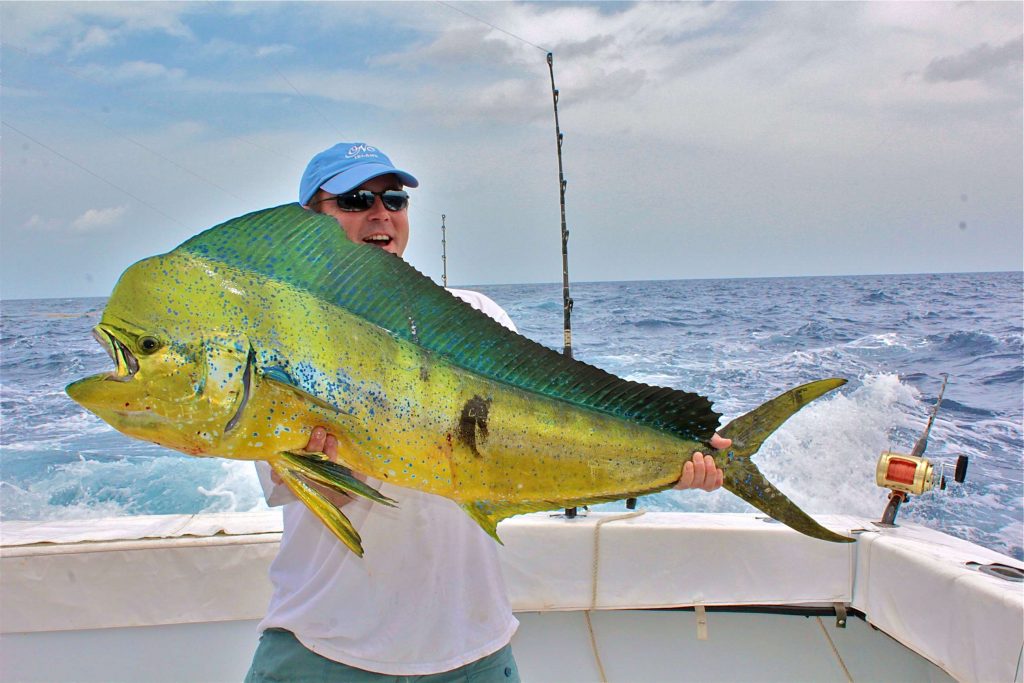
The clear blue and purple water of the wide-open Gulf of Mexico showed the flashing deep-water prisms that tell an angler that the shallow waters of the coast are far away. On this overnight fishing trip, there’s no line of coast on the horizon and the small craft have been left far behind.
The only thing other than water and sky that can be seen this far from shore is a floating city of lights and machinery. One of the massive offshore oil drilling rigs grows rapidly larger as we approach the structure. This oil rig and the waters surrounding it are our main destination for this blue-water fishing trip. For the rest of this day, through the night and for the next day, this crew of eager anglers will be in the land of the giants where the biggest of big-game fish are found. Tuna, billfish, wahoo, big dolphin fish, also called mahi mahi, and the rest of the biggest of the hard-pullers are here.
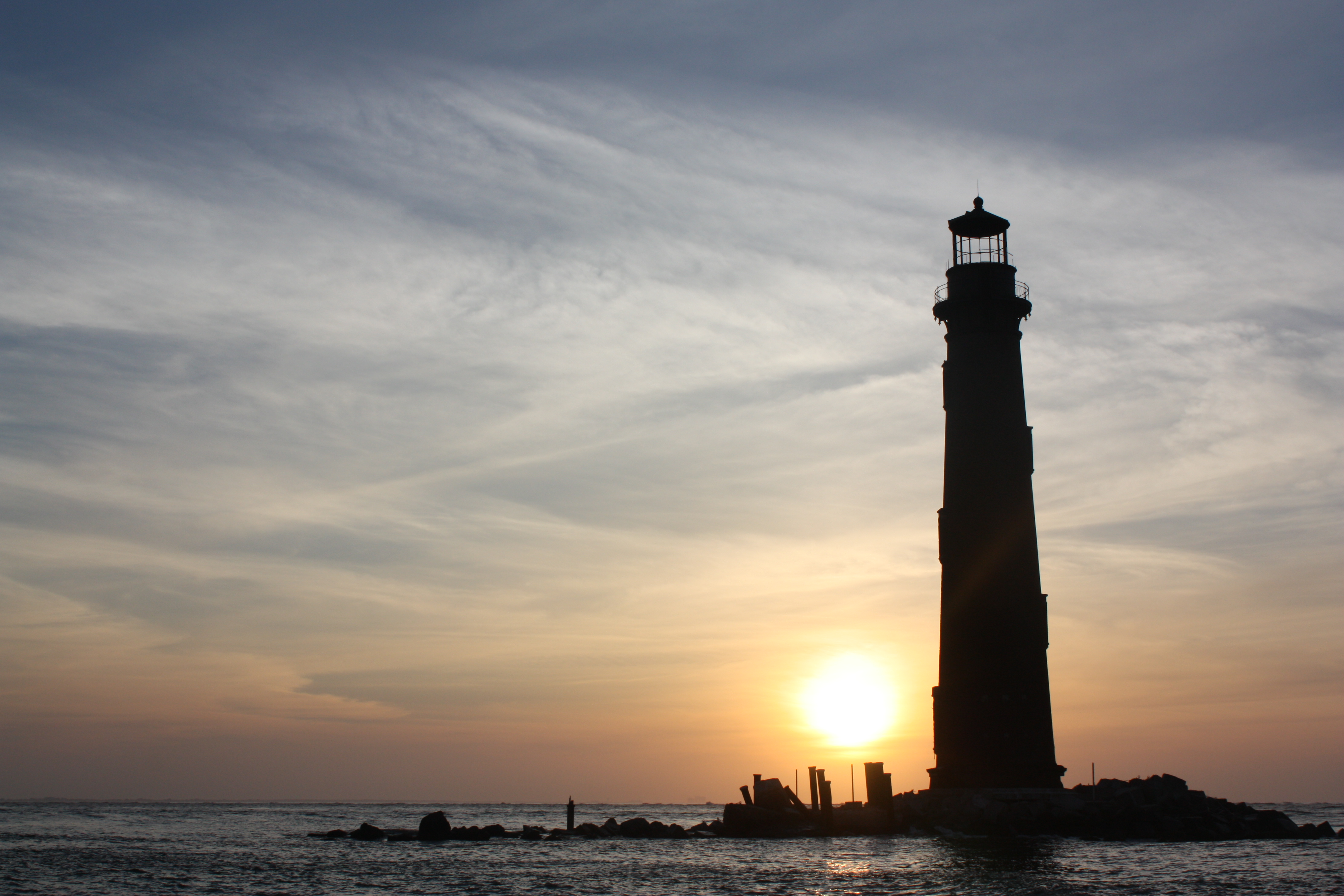
The Ultimate Fishing Trip
For anglers who want the ultimate multi-day fishing adventure, there’s nothing quite like an overnight fishing trip far out into the Gulf of Mexico’s beautiful blue waters. On the long run from Dauphin Island, we stopped at a variety of reefs and wrecks to see what was home. Snapper, triggerfish, several kinds of grouper and some very big, mean amberjack came over the rail at these stops. With the reef stops, we are just getting the crew limbered up for the real deal of this trip.
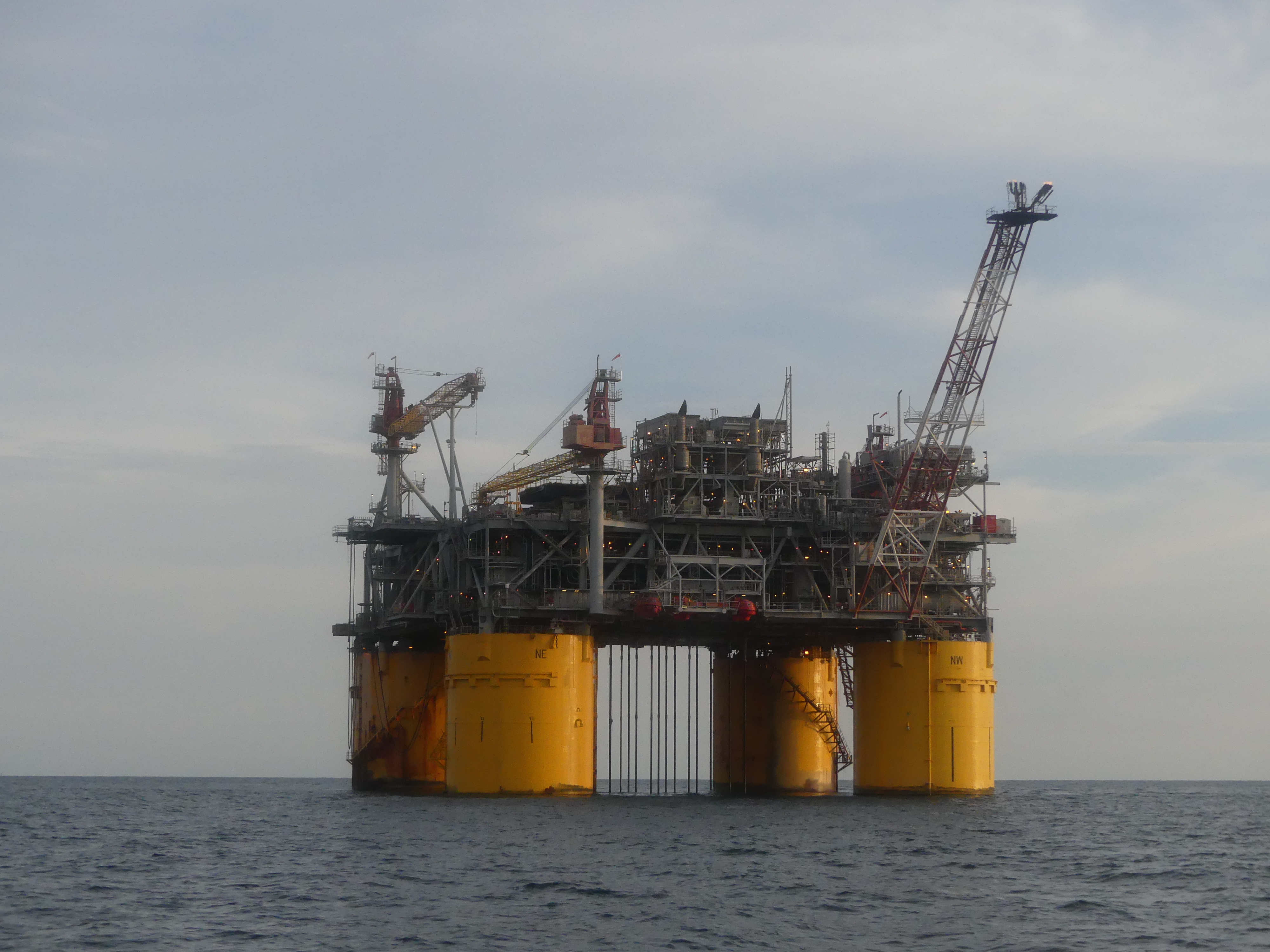
As the loaded boat approaches the oil rig, trolling lines go over the stern. A wide range of lures and baits begin to skip and jump in the boat wake. Quite soon, lines become tight. Some smaller blackfin tuna and an occasional larger yellowfin tuna start to come to the boat where they are gaffed and lifted over the rail and then deposited in the massive fish box.
Although this late afternoon fishing in motion is fun, I can’t wait for the night to fall. When the lights on the boat come on, the deep-water jigging begins. More on that later.
The day starts to move into dusk. Supper is served and eagerly eaten. Anglers clean up from their day of fishing and the long trip from Dauphin Island 80 miles out into the gulf. The lights from the massive oil rig twinkle in the deepening night. Some of the anglers give in to exhaustion and head to the comfortable bunks and air conditioning below, but the nightshift is getting ready for the real fun of an overnight fishing trip.
I check the knots and lines on my heavy tuna-jigging rig. The 60-pound-test braid line and 85-pound-test fluorocarbon leader give me a chance to land anything that might come along after darkness falls and some pretty big stuff just might come along. I have a heavy jigging spoon ready.
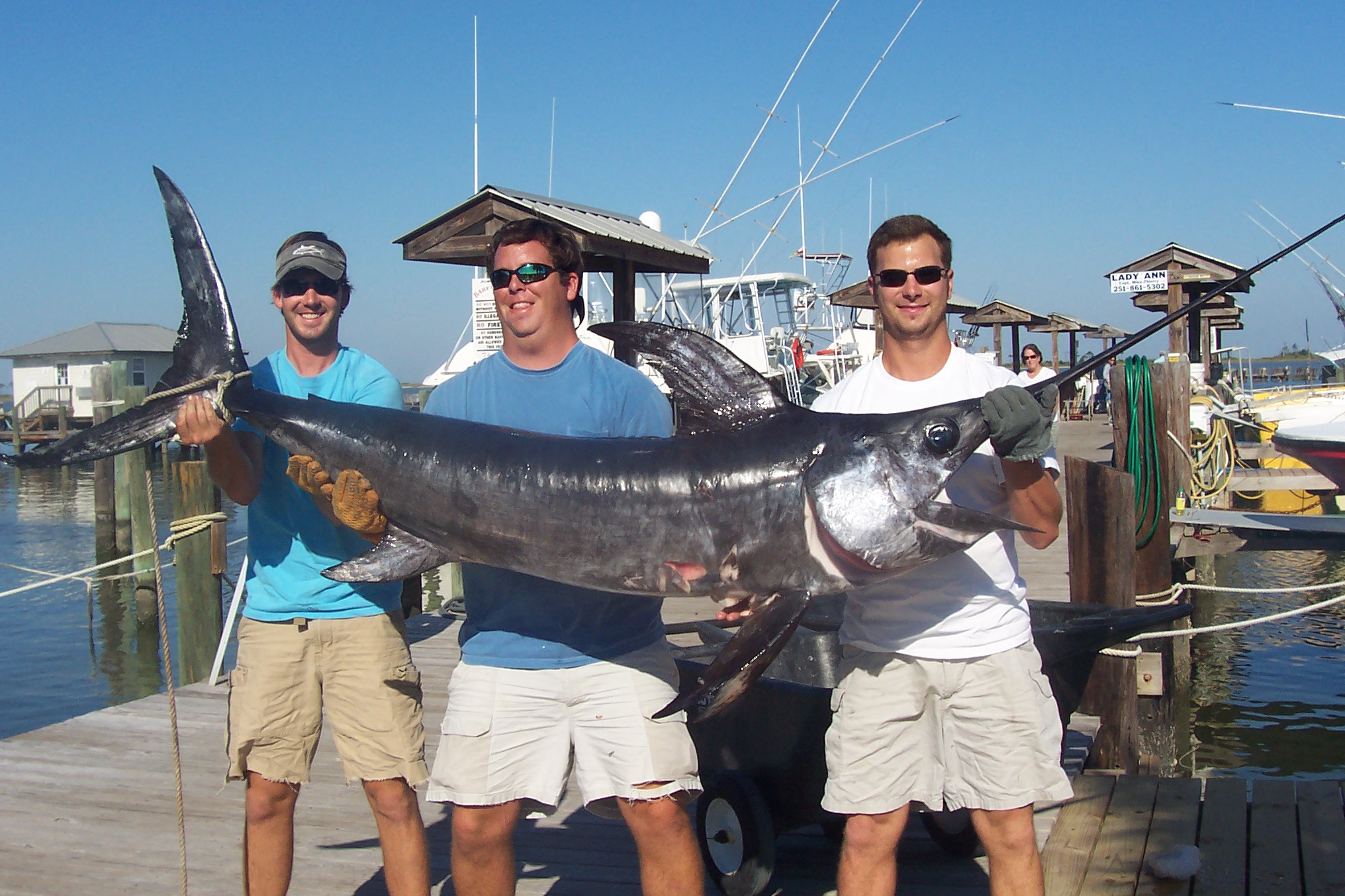
Then, the captain shuts down the engines and we drift silently on the flat, calm gulf. We’ll drift all night. Lights that shine down from the boat into the darkening water light up a circle of brightness. Soon, small squid and other potential food for bigger fish start to flash through the light. Then, just like that, it’s dark and night is here.
I drop my heavy jig into the water and let it freefall out of sight into the black water below. For a couple of minutes, I do nothing but let the jig fall. Then, the jig stops, but the bottom is still a few thousand feet below. It’s something else that has stopped the fall of my lure.
I engage the reel, take up slack and then reel as fast as I can. My rod bends way far over. My reel drag gives some line and I am in a battle with something far below that doesn’t want to come up. It takes me a few minutes and some intense effort, but before long, I can see flashes far below me in the clear water at the edge of the circle of underwater light.
This blackfin tuna is not huge, but a 20-pounder like this one that I hooked is a true big-game fighter. Once caught, it will be delicious on the grill.
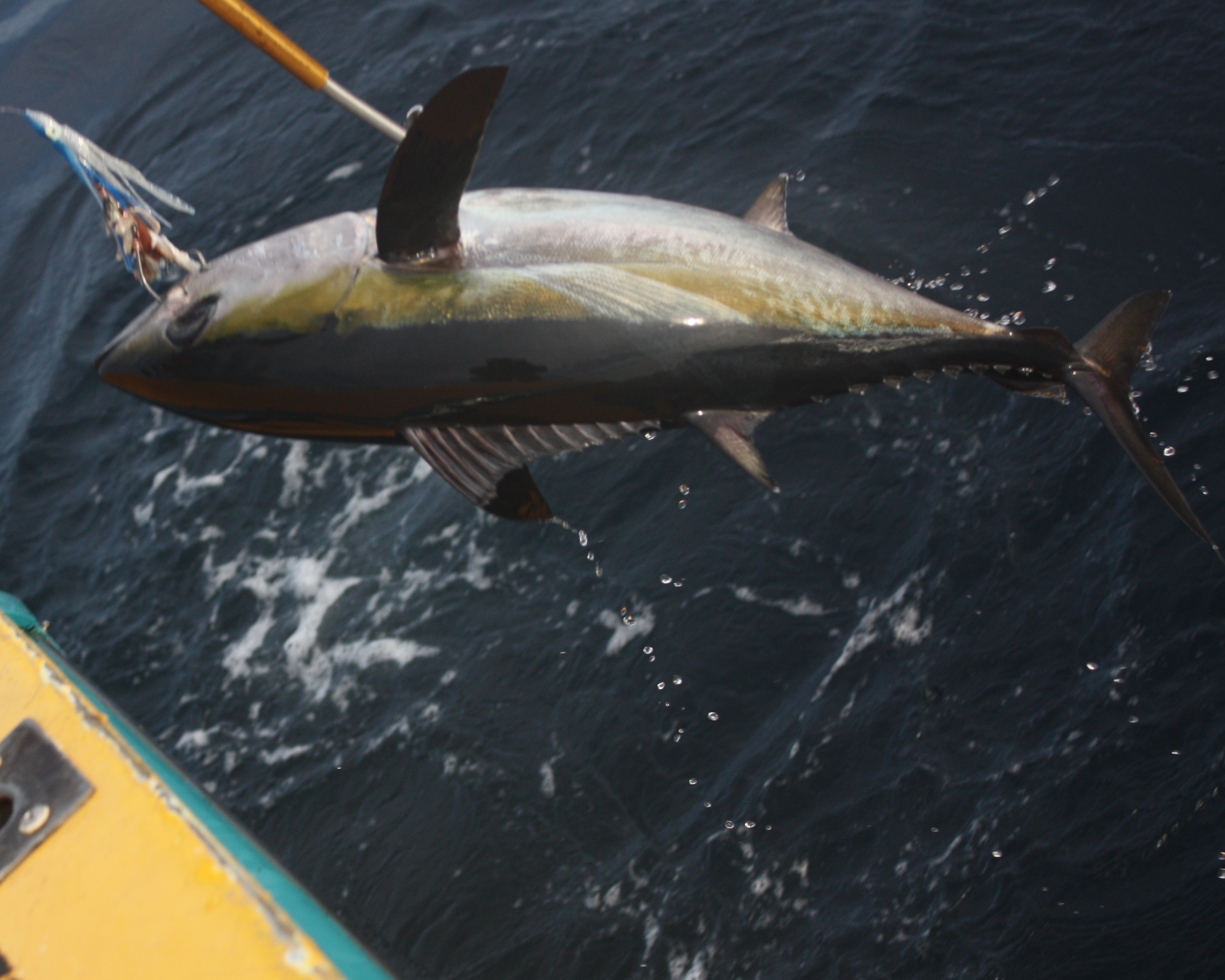
I have the tuna at boat side. A buddy with a gaff reaches down. With a jerk and a lift, my first tuna of the night is thumping the deck. I remove the circle hook of the jig and carry the tuna to the fish box. This is just the first of very many tuna we’ll catch this night.
Blackfin tuna are only a small part of the total blue-water fishing package that anglers will receive on an overnight fishing trip on the Gulf Coast. There are very many potential fishing and catching rewards on this kind of fishing trip.
Getting Ready By Planning Ahead
Anglers who want to take a long distance overnight fishing trip will soon realize that this sort of trip doesn’t happen every weekend. Such a multi-day trip will require some planning and some good weather luck, too.
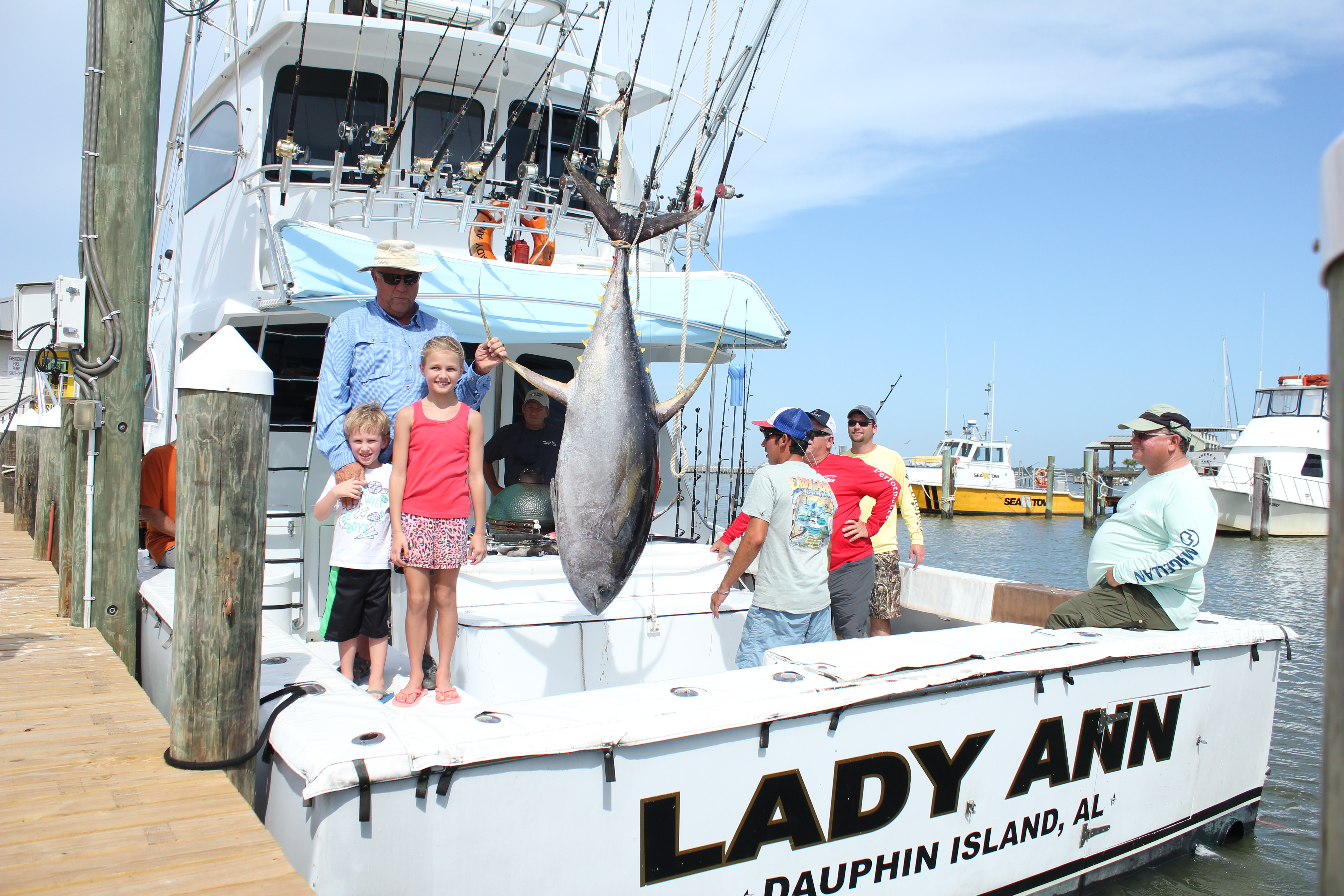
Capt. Mike Thierry and his son Skipper have been running long distance blue-water trips out of Dauphin Island for a long time. They can give us some good advice when it comes to planning a blue-water trip.
According to the Thierrys, anglers looking to set up a long distance blue-water trip should start their planning six months to a year in advance. If you are committed to a short time frame when you must take your trip, set it up as soon as possible to make sure you get the dates you want. Of course, the captains will take you any time that the boat is available. Some scheduled blue-water trips do have openings, so short notice on trips is fine, too.
Captain Mike says, “March 1 through October 31 is usually when we fish. That is the best time to go weather-wise and fish-wise. We always tell people to book early in the year in case the trip has to be cancelled due to inclement weather. That way, you still have time to regroup and try again later that year.”
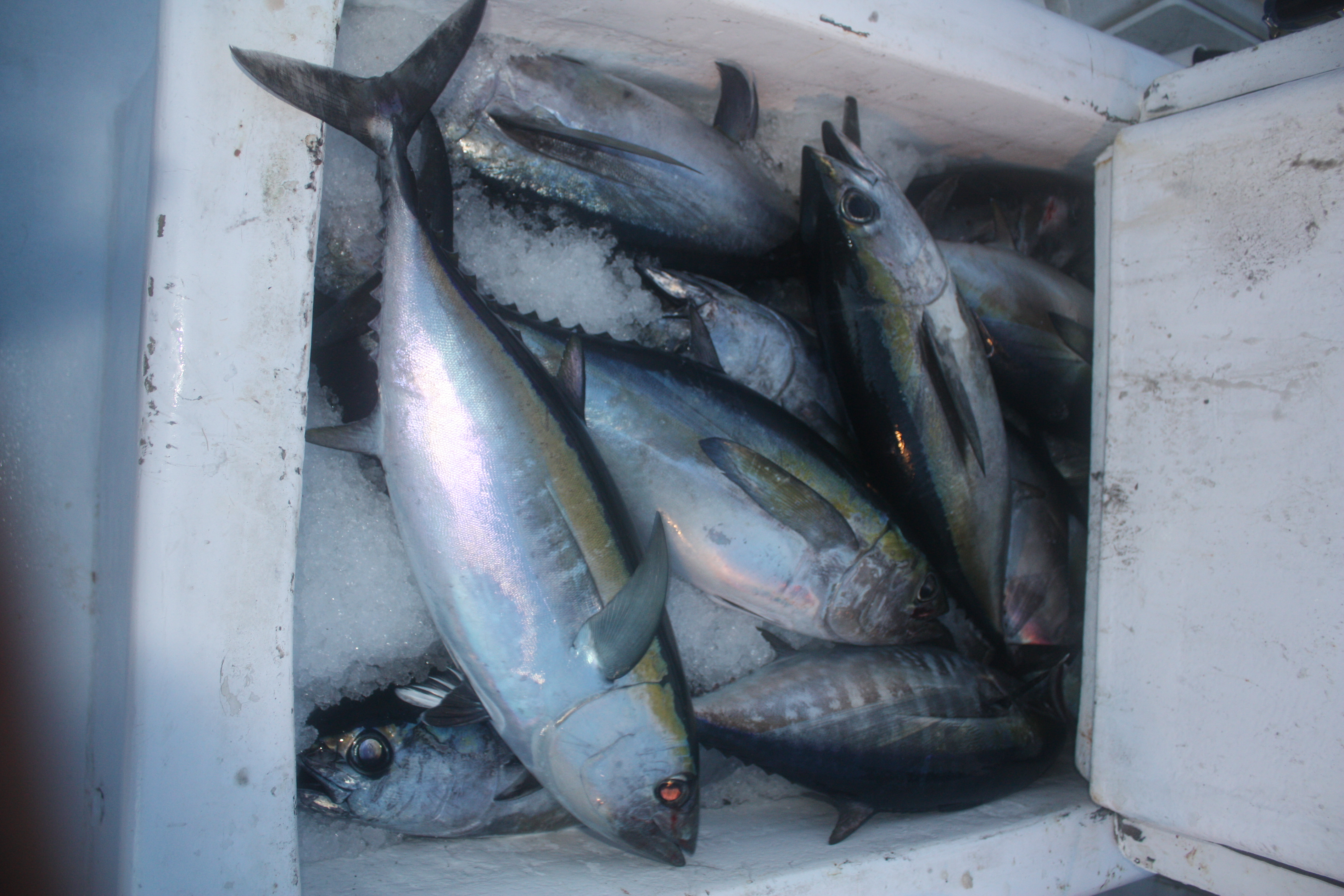
A long range, 2-day blue-water trip is not cheap, but it compares favorably to two full days of inshore fishing with a guide. Captain Mike says, “Most trips have 10 people on them. The usual cost to each angler is $650 per angler and there will be a tip for the deckhands (the best money the angler will spend on this kind of trip). Fish cleaning will cost extra, but it’s worth the cost to have an expert clean and fillet the caught fish.”
For the trip, each angler will need to bring a pillow, sleeping bag and towel. There’s a hot shower on board and food. A Big Green Egg grill is on board for cooking and microwave for heating. Bring lots of water and soft drinks. Alcoholic beverages are allowed, but please drink responsibly. Sunblock, sunglasses, hat and Ziplocs come in handy.”
We’re Not Catching Bream Here!
Overnight blue-water trips are different from afternoon quick runs to the local bass pond.
Capt. Mike Thierry tells us, “We can bottom fish some. We keep up with what is biting where, so we plan our trips accordingly. We troll for the big-game species like tuna, wahoo, mahi mahi, blue marlin, white marlin and sailfish. We fish with live baitfish around the rigs and chum/chunk for tuna. We also fly a kite with a live bait under it for tuna and we use jigs. During the course of a trip, we may do all of the above. We try extremely hard to make sure we catch fish.”
When it comes to the fish that are commonly caught on the overnight fishing trips, anglers need to come ready for some work and fun.
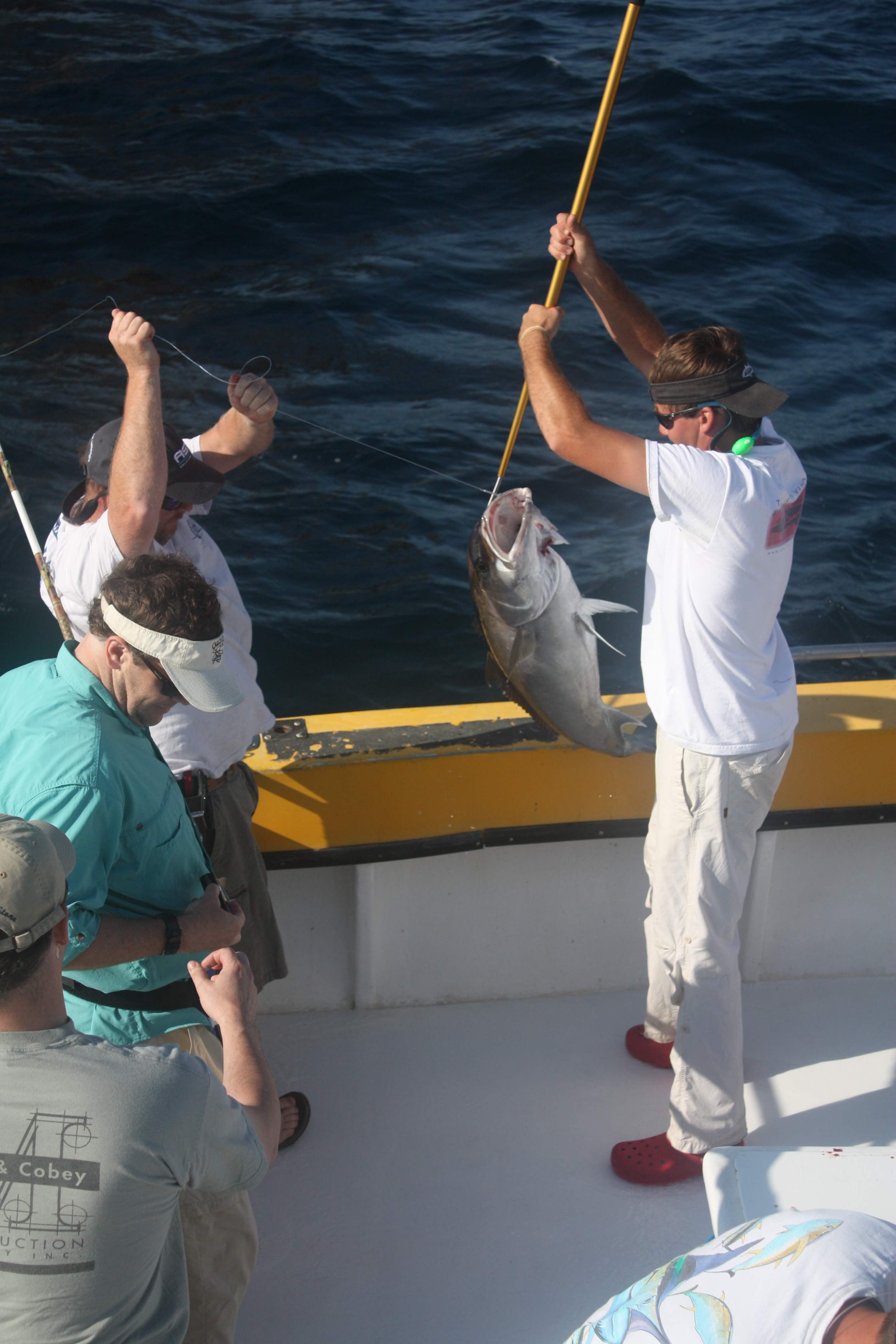
Capt. Skipper Thierry says, “ Yellowfin tuna average 40 to 80 pounds, but it is not uncommon to catch them up to 200 pounds. Blackfin tuna average eight to 15 pounds and a big one is 25 pounds. Wahoo average 30 to 50 pounds and can go up to 100 pounds. Mahi mahi average 15 to 25 pounds, but they can exceed 50 pounds. Blue marlin average 200 pounds, but the biggest one we’ve ever caught was a whopping 753 pounds. Swordfish average about 50 to 120 pounds, but they can go up to 450 pounds. A normal fight with one of these big fish can be as short as 30 minutes or last up to several hours or more – man versus fish!”
Special Considerations
A blue-water trip is a true long distance run. When the boat arrives at the fishing grounds on a blue-water trip, anglers will be far away from land and everything that goes along with that. Quite literally, the boat and its crew are out of touch with most of the regular means of communication. The boat has its radio communications, of course, but individual anglers probably won’t be able to check in at home or keep up with business while on the trip.
Cell phones won’t work when the boat clears the inshore waters, so an overnight fishing trip means anglers will be out of touch with land and all of the troubles that come from being on land. This loss of cell phone use stresses some folks, but I like being out of touch quite a lot when I’m on these trips.
When booking a long distance overnight blue-water trip, anglers need to keep in mind that the boat won’t turn around and bring a seasick angler back to port, thereby ruining the trip for everyone else. If seasickness is a problem, make sure that Dramamine or other effective seasickness medications are aboard. Any other health considerations such as daily medications must be kept in mind. Bring the meds along and take them on schedule.

A common “problem” that anglers on overnight blue-water trips have to deal with is that often the anglers will come back to shore with lots and lots of delicious fish. Good storage and care of the fish should be arranged beforehand. Offering some fresh fillets to friends and neighbors is a good way to deal with the load of fresh fish that will likely go home with each angler on a long distance fishing trip.
Another special consideration for anglers looking toward one of these big-game overnight fishing trips is that a little work geared toward getting the angler in good physical shape and ready for some very hard, but very rewarding, work catching some very big fish is a good idea. Catching big tuna or billfish requires anglers to be in pretty good physical condition.
Important Contact Information:
Captain Mike’s Deep Sea Fishing
251-861-5302
www.captainmikeonline.com
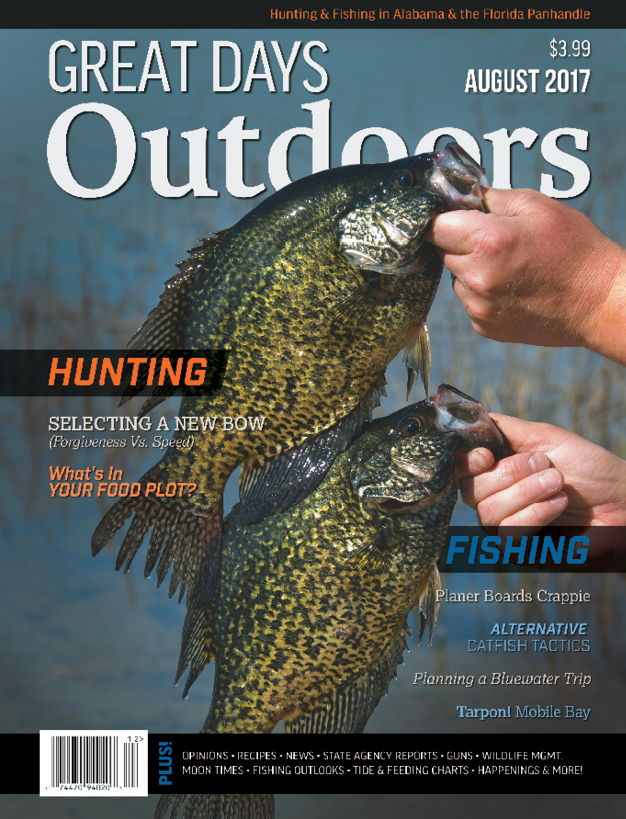
This article first appeared in the August 2017 print issue of Great Days Outdoors Magazine. For more great hunting and fishing content for the deep South, subscribe to Great Days Outdoors print and digital editions or click the image to download this issue.
Sign up for our email newsletter
Hunting and fishing tips, fishing reports, product reviews and more for the Southern sportsman.

Great Days Outdoors is the essential hunting and fishing guide for hunters and anglers with hunting and fishing tips, fishing reports, product reviews and more.
DISCLAIMER: Articles may contain affiliate links which enable us to share in the revenue of any purchases made.
FREE SHIPPING OVER $99*

Item added to your cart
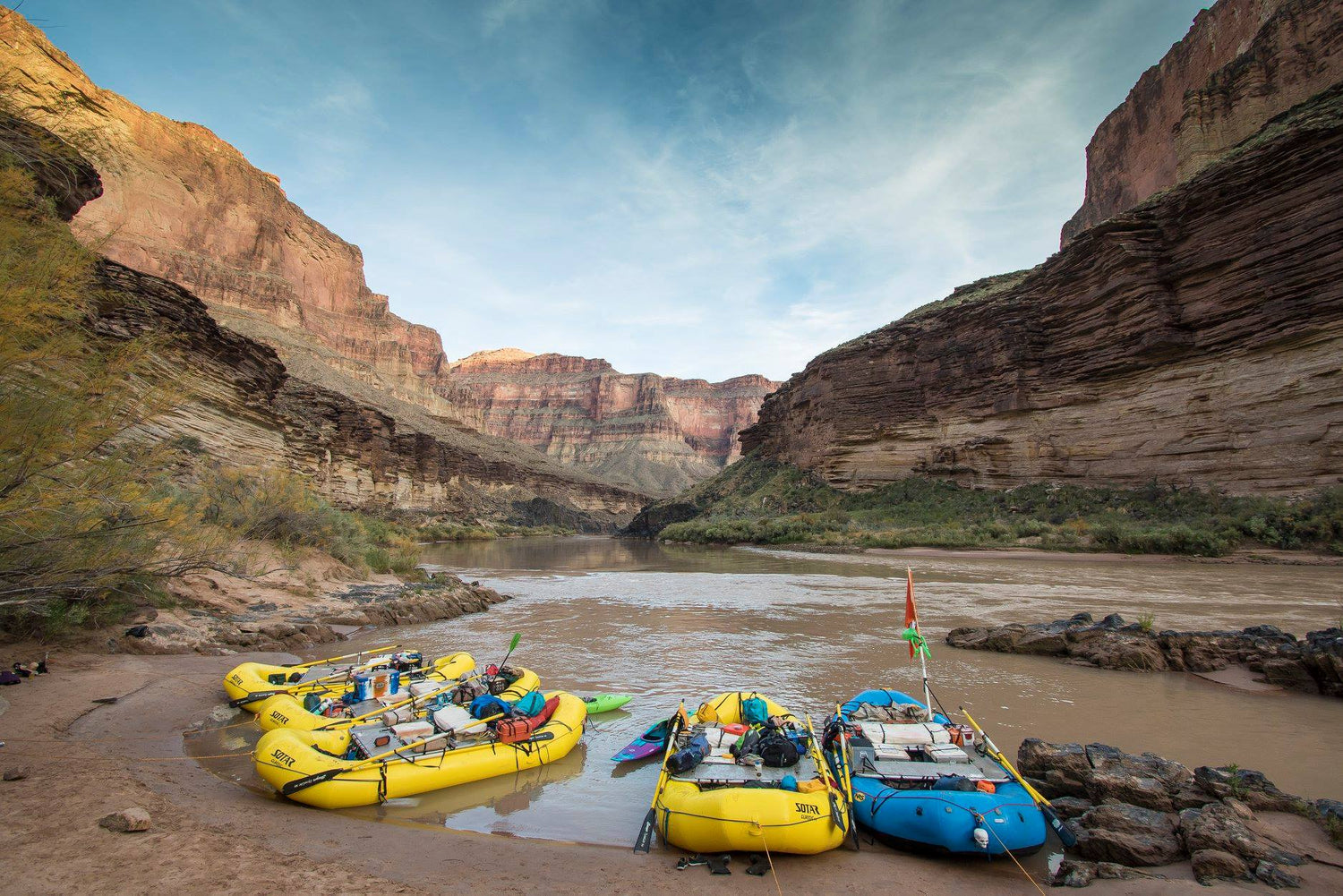
What to Bring on an Overnight or Multi-Day River Trip
This checklist is meant to be a reference only and is not a definitive gear list for overnight and multi-day river trips. Some items required by river regulations may not be listed here. Some items listed may not be required. Please refer to your river’s written regulations. Regardless of regulations, every river is different and may require more and/or specialized equipment. Do your research before your trip and plan accordingly. Remember to always pack out all trash and leave campsites better than when found. Enjoy the river!
Click here for a printable version.
- Oar locks and spare
- Oars / Spare(s)
- Cargo Floors/Gear nets
- Bail bucket / bilge pump (for standard floor boats)
- Throwbag / Bowline / Fliplines
- Umbrella / Bimini
- Water guns / toys
- First Aid kit (1 minor kit on every boat/ 1 major kit per group)
- Helicopter Emergency Landing Signal (Grand Canyon requirement)
- Emergency signal mirror
- Sand Stake / Hammer
- Medium sized climbing camalot / nut (for anchoring to rock walls)
- Paddle / Spare / Handpaddles (1 spare for every ~3 kayaks)
- Spray Skirt
- Small drybag(s)
- Small first aid kit
- Paddle / Spare
- Boat / outfitting
- Paddles / Spares
- Dry barrels
- Bilge pump / Bail bucket
Camp/Kitchen
- Kitchen shelter
- Propane / Fuel
- Pots / Pans / Griddles
- Dutch Oven(s) / Charcoal
- Coffee press / percolator
- Cooking utensils / can opener
- Plate / Cup / Bowl / Silverware (1 set per person)
- Spice kit / oil / sugar / salt, etc.
- Camp Cookbook
- Hand sanitizer / bleach wipes / paper towels
- Trash bags / containers
- Can smasher
- Ground cloth
- Small shovel
- Waterproof matches / lighters
- Water Jugs (at least 1 gallon per person per day)
- Water purifier
- Dish buckets
- Dish drying bag
- Soap & Bleach
- Dish scrubs
- Toilet / groover
- Wag bags (toilet alternative. Not accepted on all permitted rivers)
- Toilet paper
- Hand sanitizer
- Hand wash station
Personal Gear: (very subjective, varies by trip length and temperature)
- Dry / Splash gear
- Thermal layers (2 sets, NO COTTON)
- Base layers / swim wear (2 sets, NO COTTON)
- River shoes / booties
- PFD (Type III or V, 1 spare per group, coast guard tag must be readable)
- River Knife
- Gloves / Pogies
- Day drybag (for extra / dry layers, snacks, etc)
- Pelican case for camera, etc
- River Guide Books
- Water bottle
- Sunglasses with Chums straps
- Tent / Bivy
- Sleeping Bag
- Sleeping Pad
- Large Drybags (enough to fit all your stuff)
- Camp Chairs
- Headlamp / flashlight
- Camp clothes (2+ full sets, cotton discouraged)
- Thermal wear / Jackets / Fleece
- Hiking shoes & sandals
- Hat(s) (Fleece, sun)
- Toiletries kit (tooth brush, toothpaste, deodorant, sunscreen, lotion, tweezers, nail clippers, etc.)
- Personal first aid (ibuprofen, bandaids, anti-diuretics, etc)
- Choosing a selection results in a full page refresh.
- Opens in a new window.
Just added to your cart

The Ultimate Fishing Trip Checklist: Everything You Need
The number of anglers on the water has grown to its highest level ever. The global sports fishing market is projected to reach over $18 billion by 2027 !
There's no feeling comparable to being on the water, so it's no surprise that more people are getting... hooked.
Whether you're a new fisherman or an experienced angler, it's important to maximize your water time so you can fully enjoy your planned fishing trip. The key to fully enjoying your trip is preparation. The more prepared you are, the less time you have to spend handling unforeseen circumstances.
In this article, you'll be learning about the essential fishing supplies to pack before hitting the water!
Prepare for Any Weather
Fishermen often have to cut their trips home due to the weather. The weather can be unpredictable, and some situations cannot be avoided. But the more prepared you are, the more weather conditions you'll be able to handle!
Don't forget to check the weather reports in advance, so you can prepare for the specific conditions of your destination. Set weather alerts on your phone before going out so you can be notified of any dangerous weather developments.
If you're going on a full-day fishing trip, don't forget that weather can change throughout the day and it's best to be prepared for any potential shifts.
Cold Weather
If you're going on a wintery fishing trip, the key is insulating layers like long underwear. It's best if you bring more layers than you think you need. The weather can change over the course of the day, so you'll be able to add or remove layers as needed.
Don't forget earmuffs, a warm hat, and gloves to keep your fingers warm. And don't forget to bring backup clothes and socks, just in case you get wet! Nothing ruins a fishing trip like cold fingers and wet socks!
Water Protection
Waders and waterproof boots are fishing essentials, especially for river fishing. Don't forget a towel to dry off, and a swimsuit if you want to take a swim break!
If you're a fan of fishing boat trips, you know all about wind chill. As the wind blows across the water's surface, it can chill you right to the bones. A windbreaker is a great outer layer to stop the wind chill and protect you from light rain.
Bring your raincoat too, in case of heavy rain!
Sun Protection
The WHO reports that one out of every three cases of cancer is due to melanoma, or skin cancer. One of the biggest risk factors for skin cancer is sun exposure from outdoor sports. The sun reflecting off the water can damage both your eyes and your skin, making you vulnerable to skin cancer.
Don't forget a big bottle of sunscreen. It's vital to frequently apply and re-apply sunscreen. Even if the weather is cloudy, UV rays are still hitting you so lather up.
Polarized sunglasses can protect your eyes from damage as the sun reflects off the water and into them.
Personal Supplies
If you're going on a multi-day fishing trip, you'll need to bring camping supplies, so don't forget any medications you need to take, as well as biodegradable soap, shampoo, and toothpaste.
Insect repellant is often forgotten by anglers, who get end up getting eaten by mosquitoes while they're on the water!
Other personal essentials include a first aid kit, scissors, cash, batteries, and a phone charger. Consider a waterproof camera to snap photos of your catches, and a waterproof bag for your phone and money just in case.
Make sure you pack a lot of food for the day. Being stuck in the wilderness without food and water is no joke, so always plan ahead of time and bring more than you think you'll need.
Avoid salty snacks, alcohol, and soda. These will dehydrate you. Opt instead for sandwiches, salads, fresh fruit, and plenty of water.
Bring a pack of hand wipes, so your food doesn't contaminate your bait. Sometimes your food will ruin the scent of the bait, and fish will be less likely to go for it. Clean your hands after handling fish too, to avoid contaminating your own food.
Sustainability
Make sure you bring a plastic bag for your trash. Everything that you bring with you, you should also bring back. Be sure to get familiar with the guidelines for disposing of waste properly .
If you're careful with the natural spaces you enjoy, everyone can keep enjoying them for a long time!
Keep only the fish you can eat, and let the rest go. There's no need to let fish go to waste. Nothing tastes better than fresh fish, so you don't need to fill up the freezer either.
Besides, when you run out of fish you'll have an excuse to go out fishing again! You can read more about how to catch and release to help conservation efforts in this article .
Fishing Trip Supplies
The most obvious supplies are your fishing tools! You know your fishing kit best, so you can make your own list of essentials, but here are a few recommendations.
Study the area you'll be fishing in ahead of time. If you know what fish are found in the area, you can tailor your bait and lures to that species. You never want to be fishing and realize you left the perfect bait box at home.
How many times have you jabbed yourself with your hook or struggled to tie the perfect knot? Cut down on hook injuries and make your fishing experience easier with a Hook-Eze : a tool that holds the hook in place while you tie the knot.
It can trim the fishing line, remove the hook from the fish's mouth, and even cover the hook during travel. The less time you spend fussing over getting the perfect knot, the more time you can spend enjoying your trip.
Plan a Trip Today
If all this talk of fishing has made you want to plan a fishing trip, don't hesitate! Look up your dream location and get your fishing kit together.
Don't forget to pack a Hook-Eze , one of the best fishing tools available. It's popular with anglers around the world, so give it a chance and see how it can improve your next trip!
- Share Share on Facebook
- Tweet Tweet on Twitter
- Pin it Pin on Pinterest
- Choosing a selection results in a full page refresh.
- Press the space key then arrow keys to make a selection.

17 Top Fishing Trip Packing List Items for 2024 + What to Wear & NOT to Bring

When it comes to rewarding wilderness experiences, nothing beats casting a line and bringing home a fresh-caught salmon or mahi-mahi. Fishing is a great way to combine spending time outdoors with catching healthy food to share with your friends and family.
Whether you are headed for alpine lakes or the open ocean for your next fishing trip, you’ll need to be prepared with the right equipment. In this article, we’ll cover everything you’ll need to pack for a safe and fun fishing adventure. Below is a packing list of essential items to bring on a fishing trip with links to Amazon for your convenience, plus info on what NOT to bring or wear.
What to Pack for a Fishing Trip - 17 Essentials
1. packing cubes.
All experienced fishermen understand the importance of packing right and that on a fishing trip, organization is everything. These HERO Packing Cubes make it possible to pack your clothes in a much smaller space, which means you can bring more fishing gear. They also make it much easier to find your clothes when you need them.
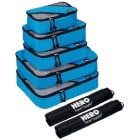
View on Amazon.com ➜
2. Fishing Pole
For most kinds of recreational fishing, the pole is the most important piece of gear. This telescopic fishing rod is perfect for drive or hike-in fishing trips, and it’s an ideal setup for small to medium-sized fish. Remember, different types of fish require different poles, so you’ll need to swap poles for fly fishing or large saltwater fish.

3. Neck Wallet
I bring this on all of my international fishing trips. Sometimes, in order to get to the best fishing spots, it’s necessary to travel through dangerous areas. In order to protect my most important belongings from pickpockets, I keep my passport, cash, credit cards, and keys in my HERO Neck Wallet. Since using this neck wallet, I’ve traveled through dozens of countries on five continents and never had a single dollar stolen.
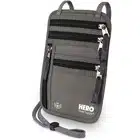
4. Squid Lures
These squid lures work like magic for large saltwater fish in tropical areas. In 65,000 miles of sailing all over the world, I’ve tried every lure I could get my hands on. But for tuna and mahi-mahi, I’ve had the best luck with these squid lures. I tow one of these behind my boat almost all the time while sailing offshore.

5. Cooling Towel
On a fishing trip, your towel has too many uses to count. Of course, it’s great for drying off after a swim, but it can also be used to clean up a mess or protect an injury while someone gets the first aid kit. This towel is perfect for travel, since it packs away to a very small size, and it dries off in minutes.
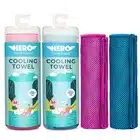
6. Tackle Box
Every fisherman needs their tackle box. That’s where you’ll keep your extra line, hooks, sinkers, bait, and tools. I found the Flambeau Two Tray Tackle Box to be an ideal size and design for short fishing trips. It’s small and lightweight, yet has enough space to keep plenty of gear for a couple-day adventure. I use this tackle box for short trips and keep a larger one at home with extra gear for longer expeditions.

7. Quick-dry Travel Towel
If you are like me, you are probably tired of traveling with a towel that takes forever to dry off. I suffered from this problem for ages, until I discovered the HERO Quick Dry Travel Towel. It’s an ideal size for travel and dries out in no time. After taking this towel on a recent trip, I liked it so much that I ordered five more for my fishing buddies.
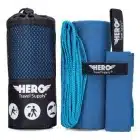
8. Heavy Duty Fishing Line
One of the most common mistakes that beginning saltwater fishermen make is to use fishing line that is too small. If you have done some lake fishing, you are probably used to using line that looks like dental floss. For offshore, you’ll need a much heavier line – like 100 lbs+. This heavy-duty fishing line has worked great for me and has yet to break.

9. Lifestraw Water Bottle
Often, I find myself running out of fresh drinking water while fishing, even when I am standing in a lake or stream. The easiest solution is to use a Lifestraw Water Bottle, which has a built-in filter, so you can fill up from any source of freshwater and simply drink. No more worrying about pumping, water tablets, or boiling your drinking water – just fill and go.
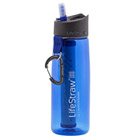
10. Lifejacket
Any time you are fishing from a boat, it’s important to wear your life jacket. The downside is that with a lifejacket on, it’s impractical to wear a fishing vest. This lifejacket was built specifically for fishermen so that you can fish safely and still keep your gear close by for instant access. This is the best lifejacket for recreational fishing I have found yet.

11. Universal Waterproof Phone Case
I tend to go fishing to get away from my phone and computer. But sometimes a smartphone is a useful fishing tool for navigation, communication, weather info, or as a camera. In order to keep my phone safe from water damage, I keep it in this Universal Waterproof Phone Case whenever I bring it on a fishing trip.
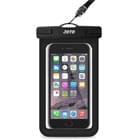
12. Hanging Toiletry Bag
Toiletries aren’t the first thing that comes to mind when you are packing for a fishing adventure, but every fisherman needs to take care of their personal hygiene, too. I take this Hanging Toiletry Bag with me on all my fishing adventures, and I’ve found it’s perfect for any trip up to two weeks.
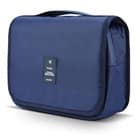
13. Floating Wrist Strap
Over the years, I’ve lost a number of valuable items simply because I dropped them into the water at the wrong time. Offshore, it’s simply too dangerous to try to dive in after a dropped item, no matter how special it is. This Floating Wrist Strap solves the problem by keeping your valuables afloat, so all you have to do is turn the boat around and scoop up the lost item.

I’ve waded across enough ice-cold rivers in my jeans to have developed a real appreciation for waders. If you like to go fly fishing or plan on standing in the water for any length of time, they are absolutely necessary. With this set of waders, you can fish all day in freezing water and still return home warm and dry at the end of the day.

15. Portable Charger
A couple of trips back, I forgot my portable charger and ended up with a dead cell phone battery and a nervous wife. Now I keep one of these chargers in my fishing vest, one in my day pack, and another in my lifejacket at all times. No matter where I am, I know I’ll get at least one more charge on my phone – just in case I need it.

16. Fishing Daypack
Like any outdoors person, fishermen need a pack to carry their gear around all day, and yet there are surprisingly few daypacks designed specifically for us. This pack is the exception to the rule, and it’s ideal for day trips to alpine lakes and remote rivers. This pack is versatile and durable, and it has plenty of room for all your gear for a full-day fishing adventure.

17. Travel Insurance
Fishing trips can sometimes be risky endeavors, especially if you like to fish offshore or in remote wilderness areas. In order to be prepared for the worst-case scenario, it’s a good idea to invest in travel insurance . You hope you’ll never need it, but if you do it could be a literal lifesaver.

Compare policies at TravelInsurance.com ➜
Other Fishing Trip Packing List Items Not to Forget
- Luggage Belts
- Luggage Locks
- Hand Casting Spool
- Handheld VHF
- Waterproof Duffel
- Sleeping bag
- Portable Bucket
- Fish Identification Guide
- Satellite Messenger
- Leatherman Multitool
- Handheld GPS
- Portable Solar Panel
- Waterproof Bags
- Trekking Pack
- Sleeping Pads
- Depth Sounder
- Fishing Weights
- Fly Tying Kit
- Insect Repellant
- First Aid Kit
- Fishing Knife
- Inflatable Raft
- Portable Radio
What to Wear on a Fishing Trip
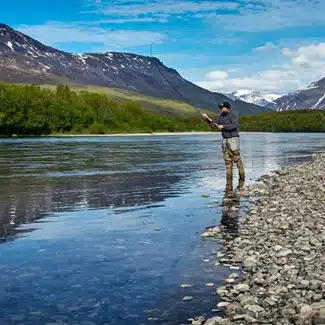
Below is a sample women’s clothing list. (All items link to Amazon.com for your convenience).

Below is a sample men’s clothing list. (All items link to Amazon.com for your convenience).

Packing for the Seasons for Fishing
Spring – march, april, may.
In the spring, you can expect to encounter a mix of rain and sun, and there is a chance of getting hit with freezing temperatures early in the season. This time of year, it’s best to dress in layers, so that you can add or remove clothing as necessary to suit the current conditions. Start with a warm base layer and add hiking pants and a long-sleeved shirt . If it’s cold, layer up with a hoodie or sweater , and if you are fishing from a boat, don’t forget to wear your life jacket.
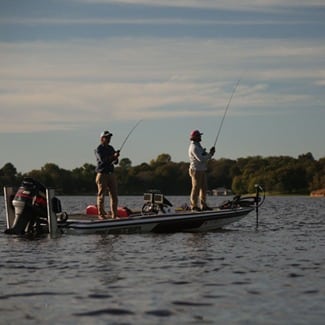
SUMMER – June, July, August
In the summer, you’ll want to be prepared for the sun and heat. It’s always nice to fish in shorts and a t-shirt , but don’t forget to put on plenty of sunscreen and wear a sunhat and glasses . If you are fishing from a boat or near a swift-flowing river, don’t forget to wear your life jacket. Evenings can be cool, so keep your warm layers and rain jacket close by.
Always remember that even in the summertime, hypothermia is a real risk. Most fishing emergencies happen this time of year when it’s least expected. If you are fishing from a boat or in a place where you are likely to fall in the water, it’s a good idea to invest in a dry suit, which will keep you warm even if you fall in the water.
FALL – September, October, November
In the fall, dress for a wide variety of conditions. Start with a warm base layer and wear hiking pants or shorts depending on the conditions. Wear activewear shirts , and always keep a hoodie or down jacket ready for use. Late in the fall, be prepared to encounter freezing conditions or even snow.
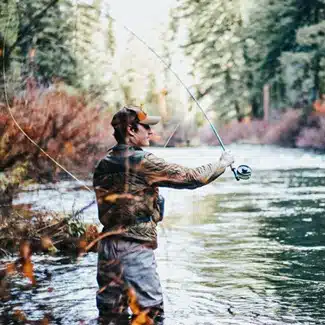
WINTER – December, January, February
Winter fishing can be surprisingly rewarding if you are prepared for the weather. I’ll never forget my first-time ice fishing from a hole cut in a lake. In the winter, you’ll likely have your favorite fishing spot to yourself.
To fish in the cold season, you’ll need to be dressed for the worst-possible weather. Start with a full set of long underwear and wool socks , then add fleece pants , a sweater , and a down jacket . Cover up with a waterproof coat and pants , and don’t forget your gloves and boots . Keep your head warm with a beanie .
Fishing in Lakes and Rivers: For fishing in lakes and rivers, you’ll probably end up wearing waders much of the time. If the weather is warm, you may only need shorts and a t-shirt underneath, with a sunhat and glasses for sun protection and a fishing vest to keep your lures handy. Keep your hoodie and rain jacket close by in case the weather changes.
Coastal Fishing: While fishing from a boat, safety should always be on your mind, even while close to shore. Whenever the boat is underway, you’ll want to wear your lifejacket . Sunburn can be a serious hazard on the water even when it’s overcast, so you’ll want to remember to wear your sun protection . If it’s windy, throw on a sweater or windbreaker to keep warm.
Deep Water Fishing: The open ocean is one of my favorite places to fish, and I’ve sailed towing a trolling line for tens of thousands of miles. On the ocean, always wear a safety harness so that you are connected to the boat at all times. The weather can turn rough fast offshore, so you’ll want to have a set of foul weather gear close by at all times. Dress in layers underneath your follies and wear waterproof boots to keep your feet dry.
What NOT to Bring on a Fishing Trip
1. don't bring expensive electronics.
It’s unwise to bring temperamental electronics anywhere near a body of water as they are likely to get damaged or ruined. Instead, bring a waterproof radio and keep your phone in a waterproof case .
2. DON'T Bring City Clothes
There is no need for a fancy suit or dinner dress on the river or out at sea. Save your fancy clothing for your triumphant return, and wear your fishing vest or drysuit instead.
3. DON'T Bring Illegal Fishing Devices
The seas are running out of wild fish, and it’s only fair to give the ones that are left a fair chance of survival. That’s why it’s often illegal to fish with a speargun, a throw net, barbed hooks, or explosives. Keep it legal and leave some fish for the next generation.
4. DON'T Bring Too Much Gear
Unless you are fishing from your own yacht, it’s likely that you’ll have to haul your gear around under your own muscle power. That’s why it’s best to leave any unnecessary gear behind, especially bulky and heavy items.
5. DON'T Bring Remote Internet Hotspots
Some people fish to get away from the rat race, others can’t stand to leave it behind. Take it from me that remote internet hot spots will rarely work on a fishing trip.
6. DON'T Bring the Wrong Fishing Setup
First-time fishermen often bring fly-tying gear to catch tuna or attempt to use a swordfish lure to attract lake trout. Take a few minutes to research the appropriate fishing gear for the type of fish you want to catch, that way you don’t have to improvise out on the water.
Just like formal attire has no place on a fishing expedition, the same goes for cotton clothing, which becomes cold once wet and increases your risk of getting hypothermia. Instead, you’ll want to dress in activewear clothing made from synthetic materials or animal hair, like wool. Don’t dress in excessively heavy or bulky clothing, as you’ll need to be agile and fast on your feet to reel in the big one.
FAQs about Fishing Trips
1. will i need to buy fishing licenses.

Sometimes, it’s legal to fish without a license in certain areas, but in 99% of cases, you’ll need to buy a fishing license. The good news is that recreational fishing licenses are usually cheap and easy to obtain. You can find fishing licenses at many general stores, gas stations, or even Walmart. It’s always better to be prepared and have a license because the fine for not having one can be pretty steep.
2. What is the best way to get started as a beginner fisherman?
If you’ve never fished before, there are many ways to gain experience. You could choose to hire a guide if you like, or maybe you prefer to simply read a book about fishing, buy a pole and tackle box and go. Most people learn best by fishing with friends who have previous experience.
3. Should I charter a boat for coastal or offshore fishing?

If you want to fish in the open ocean and don’t have previous experience, it’s a good idea to hire an experienced skipper to take you out and back safely. A professional fishing charter company should be able to take you to places with a good chance of catching a trophy fish, and you won’t have to worry about taking care of the boat.

4. Should I hire a guide?
If you are new to fishing and want to get advice from an experienced fisherman, hiring a professional guide can be a good way to get started. Others enjoy the challenge of figuring things out by themselves. If you do hire a guide, do your homework to make sure you are really hiring a professional.
5. What should I use for bait?

The ideal bait depends entirely on what type of fish you are planning to catch. Some people swear by worms, while others only use squid or minnows. I have had some luck in the tropics using dead flying fish to catch dorado. It’s best to experiment for yourself and find the type of bait that works best for you.
6. How can I go crabbing or shrimping?
Unlike fishing with a hook and line, crab and shrimp are usually caught in a trap with bait. To try crabbing, buy a pot, float, line, and permit, set it in a good spot with bait, and return several hours later to see if you have caught anything. Shrimp are caught in much deeper water. Ask the locals for the best places to give it a try.
7. Can I fish inside the National Parks?

That depends. In some national parks, park management makes use of fishermen to help reduce the number of non-native invasive fish. In many cases, you can keep as many introduced fish as you can catch. Native species inside national parks are likely to be protected. Always check the park website for regulations before you travel.
8. How can I find the best places to catch fish?
Fishing is indeed an art, and it takes many years to get good enough to develop a sense of when and where to find the most fish. But even a beginner can use a few tips to their advantage: fish like to bite around dawn and dusk, they like deep, shady pools in rivers or lakes, and they often bite when it’s raining. You’ll get more adept at spotting the signs each time you go out.
9. How long should a fishing trip last?

Some people get burnt out after just a few hours of fishing, others can go at it all day for weeks at a time and never get tired. I would recommend for beginner fishermen start with half-day excursions and slowly work up to the point where they can fish for a whole week and enjoy the entire trip.
10. What about catch and release fishing?
I have met people who only do catch and release fishing because they don’t want to kill the fish or they are vegetarians. But the sad reality is that most fish that have been caught and released don’t survive long due to their injuries. It’s best to only fish if you plan to kill and eat the fish that you catch.

- Sea Striker
- Shoreline Marine
- Propel Paddle Gear
- HQ Outfitters
- Deals on All Brands
- About Calcutta
- All Products
- Tackle Storage
- Tools & Knives
- Lures & Baits
- Terminal Tackle
- Men's Apparel
- Women's Apparel
- Travel Bags
- About Star Rods
- Explore Saltwater Series
- American Spirit Series
- Are you a RODSTAR?
- World Records
- Find a Dealer
- About Got-Cha
- Got-Cha Pro
- Got-Cha Original
- About South Bend
- Rods, Reels & Combos
- Line & Leader
- Bait Traps & Baskets
- Surf & Pier Gear
- Trolling Gear
- Gaffs & Nets
- Crabbing Gear
- Creels & Accessories
- Lures & Rigs
- Lighting & Electrical
- Motor & Fuel
- Anchoring & Docking
- Safety Equipment
- Trailer Equipment
- Accessories
- Paddles, Oars & Poles
- Anchoring & Fishing
- Lighting & Safety
- Transport & Storage
- All Coolers
- Hard Coolers
- Soft Coolers
- Fish Coolers & Kill Bags
- Cooler Accessories
- All Men's Apparel
- Fishing Shorts
- Hats & Accessories
- All Women's Apparel
- Handcrafted
Your cart is empty
20 Items to Bring on A Deep-Sea Charter Fishing Trip
May 13, 2021
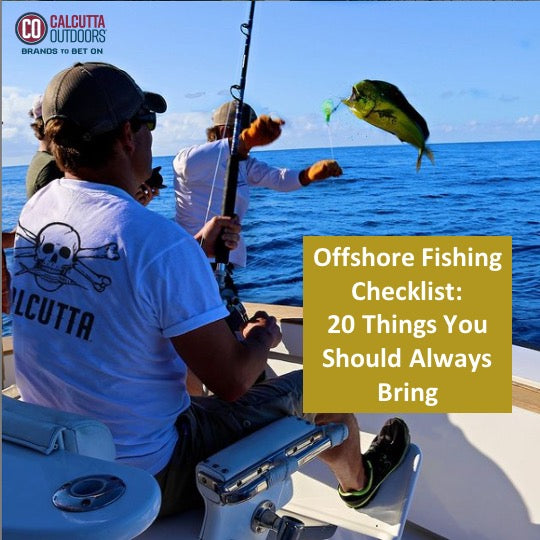
Few things are more exciting than heading offshore to chase marlin, tuna and other saltwater monsters—except maybe hauling in heavy grouper, snapper and bottom fish from the ocean’s depths. There’s never been a better time to book a deep-sea fishing trip. To help you prepare for the adventure, we’ve created this checklist of 20 essential items that you should always carry.
Rods , reels and bait are provided by the charter service, but there’s more than just fishing tackle required for a memorable offshore experience. Comfort is critical and a key ingredient to maintaining the edge needed for those line-stripping runs. Our list of essentials to bring on your first deep-sea fishing trip includes many items overlooked by first timers and a few others that will help you sail through the day like an old salt.
Mandatory Items First
Daily Medicine —Bring an adequate supply of prescription(s) you take daily. It’s unlikely the captain will turn back to shore once underway, unless there’s a life-threatening emergency. Missing one blood-pressure pill may not qualify, so bring enough for the entire trip. Extra is better, just in case weather or mechanical problems delay your return.
Motion Sickness Preventive —Bring seasickness/motion sickness medicine, even if you’re among the lucky few who have never experienced the nausea and discomfort. Those particularly prone to the condition should consult with their physician for a prescription. The inexpensive remedies available at drug stores work for most fishermen, though, and they’re great insurance to have on hand just in case.
Fishing License —More than a few trips have been spoiled when an angler discovers he or she doesn’t have their fishing license. In many cases you can purchase one at the dock, but don’t rely on using your credit card. Bring cash, just in case.
Some states, including Florida, North Carolina and South Carolina, do not require you to have a fishing license if you’re aboard a licensed charter vessel. It’s always best to check with the charter service that you’ve hired, or consult the state’s fish and wildlife website prior to your fishing trip.
Protection from the Sun
Hat —A warming sun at sunrise quickly turns glaring and baking in hot weather. Bring a hat to shade your eyes and protect your head. Bonus points go to those wise enough to choose a wide-brimmed version that shelters the nose, ears and a portion of the neck. Shop Headwear
Neck Gaiter —They stuff into the tiniest bag corners, last for years, weigh next to nothing and quality versions are so breathable you hardly know you’re wearing one. It’s the kind of added protection from the blistering sun veteran offshore fishermen rely on. For those times the water’s reflection is burning into those places the hat promised to shade, simply pull it up to cover your ears, chin and nose when needed. Shop Neck Gaiters Sunscreen —Sunburns hurt and needlessly drain energy, which makes sunscreen/sunblock a key item. Sun exposure while on the water can nearly double, so a liberal application before or as you leave the dock is wise. Repeat the procedure throughout the day. Bring plenty because someone always forgets theirs.
Sunglasses —Lengthy exposure to the sun is fatiguing and can even damage the eyes with enough unprotected exposure. A quality pair of sunglasses remedies the problem and lets you see through glare and into the action below that can be undetectable otherwise. Polarized lenses perform best at the task, but any sunglasses you choose need to be comfortable enough for all-day wear. Shop Sunglasses
Lip Balm —Sun, wind and salt spray dry everything, which makes lip balm another key ingredient for comfort. Get one with a minimum 15 SPF rating for added protection.
Long-Sleeve Shirt —Lightweight and breathable is best, but make sure it’s long sleeved. Today’s high- performance fishing shirts have UPF protection built right into the fabric. Dress in layers on cold mornings because you can always peel some off to maintain comfort as the temperature rises. Shop Sun Protection Shirts
Fishing Accessories
Hand Towel —You’re on the water, things get wet and you’re probably going to sweat during and after that first big hookup. The first mate’s priorities don’t always include handing them out, so bring a hand towel. Shop Bait Towels
Wet Wipes and Hand Sanitizer —When it’s time to enjoy a snack or lunch, you’ll want clean hands. While mates on private charter boats typically do much of the dirty work, you’ll find yourself handling both bait and fish on a deep-sea party boat.
Gloves —Fishing gloves are wise for a variety of reasons, even if the charter’s staff handles the catch on board. They won’t be carrying it to your vehicle or transferring it into your cooler. Gloves also come in handy any time extra protection is needed.
Rain Gear and Footwear
Rain Jacket —You can never be too prepared. Today’s high-tech, lightweight rain jackets take up so little space. You’ll never even know it’s there—until, that is, an unexpected squall rolls in or it’s pouring when you get back to the dock.
Non-Skid Footwear with Closed Toes —Sandals aren’t appropriate when you’re going to be boating toothy fish and baiting sharp hooks. Wet decks and rocking boats make soles that maintain their grip the best way to remain upright during your trip. Save those sandals for grilling out when you get home.
Additional Gear
Cooler —You need something to bring your catch home, so pack a cooler and leave it in your vehicle. Stuff it with ice in the morning, and the cooler will be chilled enough to get that limit of fish to the fridge fresh and unspoiled. Shop Coolers
Drinking Bottle —It won’t take long for the salt air and the fishing action to make you thirsty. Some charter boats provide drinks and snacks, but many require you to bring your own. Regardless, it’s always a good idea to bring along a water bottle or tumbler with a spill-resistant lid filled with water or your beverage of choice. Shop Drinkware
Fish Bag —It can be a long walk back to your vehicle if you’re hauling a heavy load of fish. An insulated fish cooler bag helps you easily shoulder the load while keeping your catch cold and fresh. Have a gunny sack at home? You can wet it down and you’re ready to carry your fish off the boat in fewer trips. Shop Fish Cooler Kill Bags
Cell Phone with Camera —Don’t let that once-in-a-lifetime trip become a faded memory. Bring a camera or carry a cell phone that produces quality images. Saltwater and electronics don’t play together well, so stow them in a sealed plastic bag . Turn on the flash when you do take it out for a photo to capture more lifelike colors and reduce shadows under your hat. You’ll be ready to post that catch-of-the-day photo on Facebook and Instagram as soon as you arrive back at the dock.
Cash —Cash on hand ensures you can tip the crew, get your license and pay for fish cleaning without walking the dock in search of an ATM.
Waterproof Bag —Things often get wet on an offshore fishing boat. It’s always a good idea to store your electronics, wallet, and other important items in a dry bag . While a zip-lock bag will suffice, waterproof dry bags with roll-top closures and welded, waterproof seams are the best choice. They’re durable, perfect for deep-sea fishing trips, and often feature a shoulder strap for carrying. Shop Dry Bags
Check with Your Fishing Charter —Charter services routinely provide rules and recommended gear to bring onboard. Following them improves your experience, ensures safety and often addresses conditions specific to the exact area you will be fishing. Check the charter boat’s website or contact them before your trip to make sure you have everything you need.
Visit a Local Fishing Tackle Store —Before you set foot on a charter boat, stop by a local bait and tackle store—or two. The tackle shop will likely stock many of the items on this list. And when it comes to anything related to fishing, tackle retailers are the experts. They will be happy to share their knowledge and provide up-to-the-minute fishing and weather reports.
Reading next
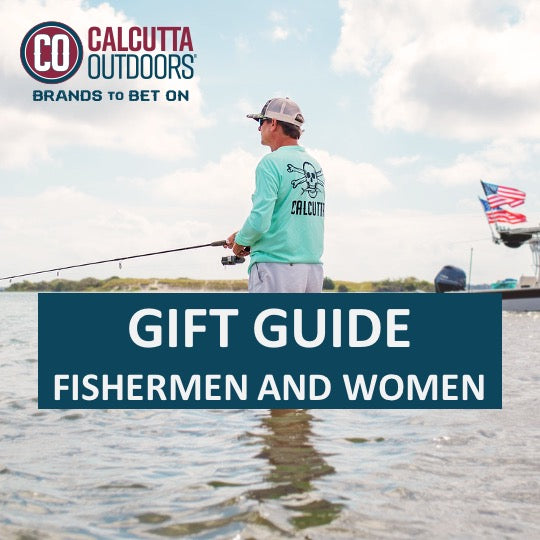
The Best Gifts for People Who Love Fishing
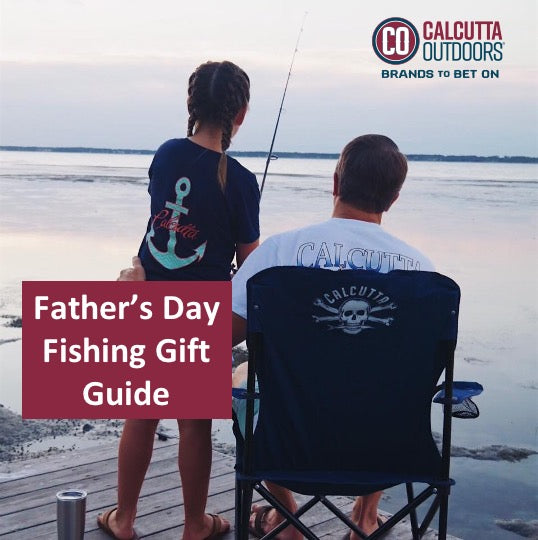
Top Fishing Gifts for Father’s Day 2021
Hubbard's Marina | Deep Sea Fishing | Dolphin Watching Tours | John's Pass Madeira Beach FL
- (727) 393-1947

Overnight Fishing Charters
Onlin Reservations
You may now book reservations for all of our famous trips through our state of the art Online Reservations system on our Web Site. We’ve made it quick, easy and secure to book your trip with us 24 hours a day!
Please note that online reservations are payable at the time of booking with a Visa or MasterCard, and are NON REFUNDABLE, unless we cancel due to weather, mechanical, or lack of minimal fare requirements.
Friday – Departs 3:00 PM returns Sunday 6:00 AM
Tuesday – Departs 3:00 PM returns Thursday 6:00 AM (Tuesday trips are scheduled as special trips only)
Fare: $329.00+Rod and Reel $25.00=$354.00+ tax $24.78=$378.78
39 hr. Overnight Trip Meal Package: $35.00 + 2.45 (tax) + 6.30 (18%gratuity) = $43.75 ea. Includes 2 Dinners, 4 Sandwiches breakfast and Lunch, 4 Chips, 4 Candy or Granola Bars, 8 Sodas and unlimited Water (excluding beer) By purchasing the meal packages for your group. the beer will be at Happy Hour price.
Since 1954 – The first and ONLY party boat to withstand the test of time running to the Florida Middle Grounds 100 mi. NW of Tampa Bay.
Hubbard’s Overnight Middlegrounds trips catch more fish than ANY other party boat on the West Coast of Florida!
Average running time 8-9 hrs. out – 8-9 hours back.
Approximately 20 Hours Fishing Time
Distance: Cruising out up to 100 miles to the Florida Middle Grounds, and surrounding areas , home to pristine coral ledges, hard bottom, potholes and natural springs that hold large numbers of hard fighting , quality game fish.
Overnight Trip Chart
Catch: Includes Grouper, Amberjack, Mangrove, Mutton, Cubera, Hog and Red Snapper, King Mackerel, Dolphin, Wahoo, Blackfin Tuna and Cobia.
Bait: Cut bait (sardines & squid ) provided on board. Live Pinfish may be purchased with 24 hr. advanced reservation. 2-3 dozen Pinfish per person strongly recommended. Private live bait wells on board available by reservation only.
Recommended Tackle: You may bring up to 3 rods strung with 40-100lb. test line. 5 or 6 ounce barrel slide weight. 4/0 to 7/0 hooks.
Visit our Tackle & Apparel Online Store
Notes: Fishing time begins around 12-1 a.m., lasting until about 8-9 p.m. This trip is like a two day camping trip, so don’t forget to bring a sleeping bag, pillow, toiletries, towel, and change of clothes. Bunks and hot showers included; meals available in the “Galley”.
For more information on tackle and a list of what to bring with you check our – Frequently Asked Questions – “Things to Know Before You Go !”
Username or email *

Discover The Ultimate Packing Checklist For Your Canadian Fishing Trip
If you’re planning a fishing trip in Canada, you’re in for an adventure. Canada is home to some of the best fishing spots in the world, with abundant wildlife and breathtaking landscapes. However, packing for a fishing trip in Canada can be overwhelming, especially if you’re not sure what to expect.
To help you prepare for your Canadian fishing trip, we’ve put together the ultimate packing checklist. This checklist includes everything you’ll need to make the most of your trip, from fishing gear to clothing and safety supplies. By following this checklist, you can rest assured that you’ll be fully prepared for whatever the Canadian wilderness throws your way.
So, without further ado, let’s dive into the ultimate packing checklist for your Canadian fishing trip. Whether you’re an experienced angler or a beginner, this checklist will ensure that you have everything you need to make your trip a success.
Keep reading to discover the must-have items for your Canadian fishing trip and make sure you don’t forget anything essential before embarking on your adventure.
Plan Ahead: Research the Location and Weather Conditions
Before heading out on your Canadian fishing trip, it’s essential to do your research. Researching the location and weather conditions will help you determine what gear to pack, what clothing to wear, and what safety precautions to take.
When researching the location, consider the type of fish you’re targeting and the water conditions. Research the best spots to fish, what bait and lures to use, and any local regulations you need to be aware of. Don’t forget to research the weather conditions, as temperatures and precipitation can vary greatly depending on the location and time of year.
Researching the Location
- Research the type of fish you’re targeting
- Research the best spots to fish
- Research local regulations
Researching the Weather
Canadian weather can be unpredictable, so it’s important to be prepared for anything. Check the weather forecast for the location you’ll be fishing and pack appropriate clothing and gear. It’s also important to know what to do in case of extreme weather conditions, such as thunderstorms or sudden drops in temperature.
Preparing for Emergencies
When heading out into the wilderness, it’s crucial to be prepared for emergencies. Pack a first aid kit, a map and compass, and a means of communication in case of an emergency. Knowing basic survival skills , such as building a shelter and starting a fire, can also come in handy.
Get the Right Fishing Gear
Having the right fishing gear is essential for a successful Canadian fishing trip. Here are some things to consider when packing:
First, consider the type of fishing you will be doing. Different types of fish require different gear. For example, if you’re fishing for trout, you may want a lightweight rod and reel, while fishing for salmon may require a heavier-duty setup.
Rods and Reels
- Consider the length and action of your rod. Longer rods are good for casting distance, while shorter rods offer more control in tight spaces.
- Choose a reel that matches the rod weight and is appropriate for the type of fishing you’ll be doing.
- Don’t forget to pack extra line and leader material.
Baits and Lures
- Research the fish species in the area and pack appropriate lures and baits. Live bait can be purchased at local shops, but bringing your own can save time and money.
- Consider bringing a variety of lures in different colors and sizes. This can increase your chances of catching fish.
- Don’t forget to pack hooks, sinkers, and other necessary tackle.
Clothing and Accessories
- Wear clothing appropriate for the weather conditions, such as waterproof jackets and warm layers.
- Don’t forget a hat, sunglasses, and sunscreen to protect yourself from the sun.
- Bring a good quality fish fillet knife and a cooler to keep your catch fresh.
By packing the right fishing gear, you’ll be well-prepared for a successful Canadian fishing trip. Don’t forget to double-check your packing list before you leave, and happy fishing!
Bring Warm Clothes and Rain Gear
When you’re planning a fishing trip, it’s important to consider the weather conditions of your destination. Even if the forecast calls for sunny skies, it’s always a good idea to pack some warm clothes and rain gear. You never know when the weather might take a turn for the worse, and being caught unprepared can make for an uncomfortable and even dangerous experience.
When packing for your fishing trip, make sure to include layers of warm clothing that can be added or removed as needed. This will help you stay comfortable throughout the day, no matter how the weather changes. Additionally, be sure to pack rain gear such as a waterproof jacket, pants, and boots. This will keep you dry if it starts to rain and protect you from cold winds.
Warm Clothes
- Thermal underwear: This will help keep you warm and dry, even if you get wet.
- Wool socks: These will help keep your feet warm and dry, which is important for preventing hypothermia.
- Insulated jacket: Look for a jacket with a waterproof outer layer and a warm inner lining.
- Waterproof jacket: Look for a jacket with a hood and adjustable cuffs to keep rain out.
- Waterproof pants: These will keep your legs dry and protect you from wind and rain.
- Waterproof boots: Look for boots with good traction and ankle support.
Why It Matters
Bringing warm clothes and rain gear is important for your comfort and safety while fishing. Hypothermia can be a serious risk, even in relatively mild conditions, so it’s important to be prepared for any weather conditions you might encounter. Additionally, being caught in the rain without proper gear can quickly lead to discomfort and even illness. By packing warm clothes and rain gear, you can enjoy your fishing trip no matter what Mother Nature throws your way.
Don’t Forget Your Fishing License
If you’re planning to go fishing, don’t forget to bring your fishing license with you. A fishing license is a permit that allows you to legally fish in a particular area. It is required by law in most places, and not having one can result in fines or even legal trouble. In addition to a license, there may be other permits or regulations you need to follow depending on the location and type of fish you’re targeting.
Before you head out on your fishing trip, make sure you do your research and understand the licensing requirements in the area you plan to fish. You can usually purchase a fishing license online or at a local tackle shop. Some states also offer free fishing days or discounted licenses for military personnel or senior citizens. Don’t risk ruining your day on the water by forgetting this important item.
Types of Fishing Licenses
- Annual fishing license: allows you to fish for a full year
- Short-term fishing license: allows you to fish for a specific period, usually a few days or a week
Where to Purchase a Fishing License
You can purchase a fishing license at a local tackle shop, sporting goods store, or online. Some states also allow you to purchase a license over the phone. Make sure to bring proof of identification and any other necessary documentation.
Benefits of Having a Fishing License
- Allows you to legally fish in a specific area
- Contributes to conservation efforts and protects fish populations
- Helps fund state and local wildlife and conservation programs
Pack Sunscreen, Bug Spray, and First Aid Kit
When planning for an outdoor adventure, it’s important to pack everything you’ll need to stay safe and comfortable. Sunscreen, bug spray, and a first aid kit are three essential items that should always be on your list.
Sunscreen will help protect your skin from the sun’s harmful rays, preventing painful sunburns and reducing your risk of skin cancer. Be sure to choose a broad-spectrum sunscreen with an SPF of at least 30, and reapply it every two hours or after swimming or sweating.
Bug spray will help keep pesky insects at bay, preventing bites and stings that can be itchy and uncomfortable. Look for a spray containing DEET or other recommended insect repellents, and follow the instructions carefully to ensure maximum effectiveness.
First Aid Kit
A first aid kit is essential for treating minor injuries and ailments that can occur while outdoors. Be sure to pack items like bandages, antiseptic wipes, pain relievers, and any necessary prescription medications. Consider adding items like a snakebite kit, emergency whistle, or emergency blanket depending on your activity and location.
Sun Safety Tips
- Wear protective clothing like long sleeves, pants, and a wide-brimmed hat to shield yourself from the sun.
- Limit your sun exposure during peak hours, typically between 10 a.m. and 4 p.m.
- Stay hydrated by drinking plenty of water throughout the day.
Bug Bite Prevention
- Avoid wearing bright colors or floral prints that can attract insects.
- Stay away from standing water, which can be a breeding ground for mosquitoes.
- Use a mosquito net around your sleeping area at night to prevent bites while you sleep.
By packing sunscreen, bug spray, and a first aid kit, as well as following sun safety and bug bite prevention tips, you can stay safe and comfortable on your outdoor adventure.
Stock Up on Food and Water Supplies
When planning an outdoor adventure, it’s important to make sure you have enough food and water supplies to last for the duration of your trip. Depending on the length of your trip and the number of people in your group, you may need to pack a significant amount of food and water.
For your food supplies, think about packing non-perishable items such as canned goods, granola bars, nuts, and dried fruits. These items are easy to pack and can provide a good source of energy for your outdoor activities. Don’t forget to pack a can opener and any necessary utensils as well.
Pack Plenty of Water
- It’s recommended to pack at least one gallon of water per person per day for drinking and cooking purposes.
- Consider using a hydration system, such as a CamelBak, for easy access to water during your activities.
- Remember to pack water purification tablets or a filtration system if you plan on drinking from natural sources.
Don’t Forget About Meal Planning
When packing food supplies, make sure to plan out your meals and snacks for each day. This will help ensure that you have enough food for everyone and can avoid any unnecessary trips to the store.
- Consider prepping meals ahead of time and packing them in airtight containers to keep them fresh.
- Bring along a portable grill or camp stove if you plan on cooking meals that require heat.
- Don’t forget to pack any necessary condiments or spices to add flavor to your meals.
Additional Tips
- Pack extra food and water supplies in case of emergencies or unexpected delays.
- Choose foods that are high in protein and carbohydrates to help keep your energy levels up during physical activities.
- Store your food supplies in airtight containers to prevent animals from getting to them.
By taking the time to stock up on food and water supplies and planning out your meals ahead of time, you can help ensure a successful and enjoyable outdoor adventure.
Frequently Asked Questions
What kind of clothing should i bring on a canadian fishing trip.
It’s important to bring layers, as temperatures can vary throughout the day. Bring waterproof clothing and comfortable footwear, as you’ll be spending a lot of time standing in the water. Don’t forget to bring a hat and sunglasses to protect yourself from the sun.
What type of fishing gear should I bring?
You should bring a rod and reel that’s suitable for the type of fish you’ll be catching. Be sure to pack extra fishing line, hooks, and lures. It’s also a good idea to bring a landing net and a pair of pliers.
Can I bring my own boat?
Yes, you can bring your own boat, but be aware of the regulations for the area you’ll be fishing in. You’ll need to have a boating license and ensure that your boat is equipped with all the required safety equipment.
Do I need a fishing license?
Yes, you’ll need a fishing license to fish in Canada. You can purchase a license online or in-person at a fishing store.
What kind of fish can I catch?
Canada is known for its variety of fish species, including trout, salmon, pike, and walleye. The type of fish you can catch will depend on the location and time of year.
What kind of food should I bring?
Bring non-perishable food items that are easy to prepare, such as canned goods, instant noodles, and granola bars. Don’t forget to bring plenty of drinking water or a water filtration system.
Privacy Overview

- 6 Hour Trip
- 8 Hour Trip
- 10 Hour Trip
- 12 Hour Trip
- OverNighter
- The Captain
- ★ Book Now ★
- Info Request
- Tour of Boat
- Fishing Trips

Come by our Store and checkout our latest items, T'shirts, Seasonings and our own branded Hooks.

A good crew can make a big difference between a good trip and a great trip!

Everything you need to know to have a good time fishing with us!

Deep Sea Fishing Reports... "What's happening in the local fisheries"
Intimidator Sportfishing - Orange Beach, Al.
Fishing Reports
Overnighters, offshore deep sea fishing on an overnighter for sportfishermen, call for more information, welcome to intimidator deep sea sportfishing inc. we are a full service charter fishing business that offers trips from 6 hour family excursions to 3 day offshore extravaganzas..
These are very productive offshore deep sea fishing trips and have quickly become one of our most popular sportfishermen trips that can be customized to fishing styles or an individual’s needs. We are very diverse and can offer you a whole range of opportunities or angling possibilities. We specialize in overnight trips, but offer trips to 3 days for the ones who just cannot get enough offshore deep sea fishing.
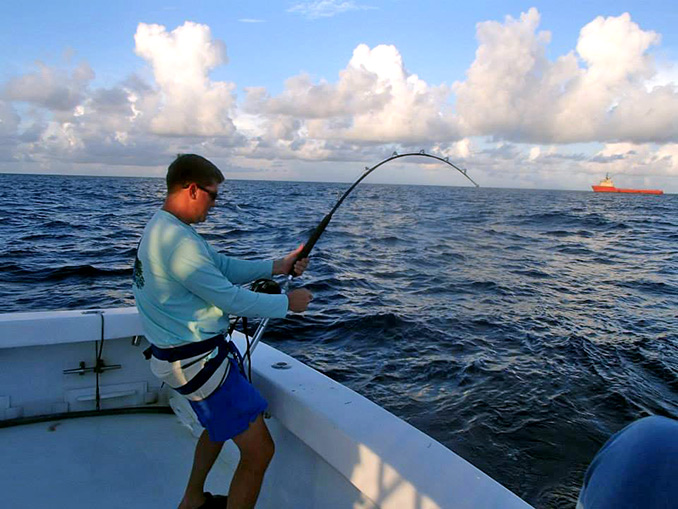
A typical overnighter usually leaves the dock about 6 am. Most of the overnight trips that we run are combo bottom / offshore deep sea fishing trips . We will start the day in some cases doing some live bait fishing. We will always make every attempt to catch all the live bait that we need before departing in the morning, it is always best to try and catch some fresh live bait just off the beach in about 20 feet of water. Most of the live bait that you will find in the “Intimidator’s 350 gallon live well” will be Pinfish, Croakers, Pig Fish and Menhaden. The bait that is usually caught in the gulf the morning of the trip will be Pilchards (aka Greenies or Elvis’), Herring, Thread fin’s, Cigar Minnows, and Atlantic Bumper fish (aka Crazy fish). The live bait can be the most important key to most any trip so the time spent here will be well served.
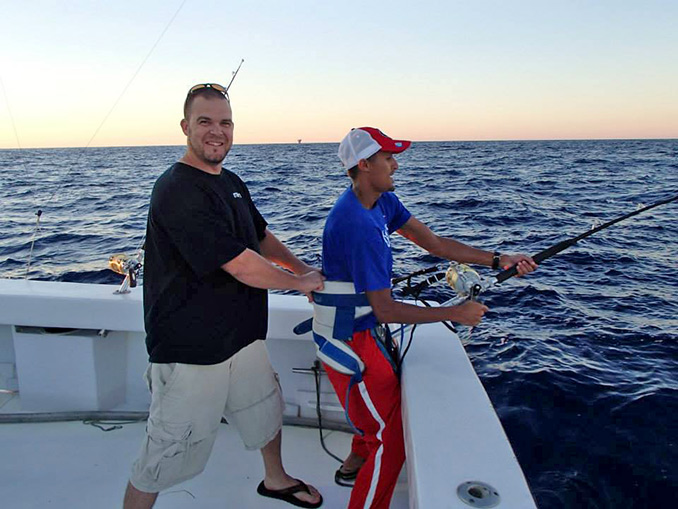
After we finish live bait fishing, we will usually put out some hi-speed trolling lures for Wahoo , King Mackerel and other fish that can be caught trolling while on the way to the fishing grounds. At this point, we will usually be working on whatever type breakfast that you may like to bring along. From there it is a flurry of activity rigging tackle, cutting bait, and giving everything a thorough inspection before the action commences.
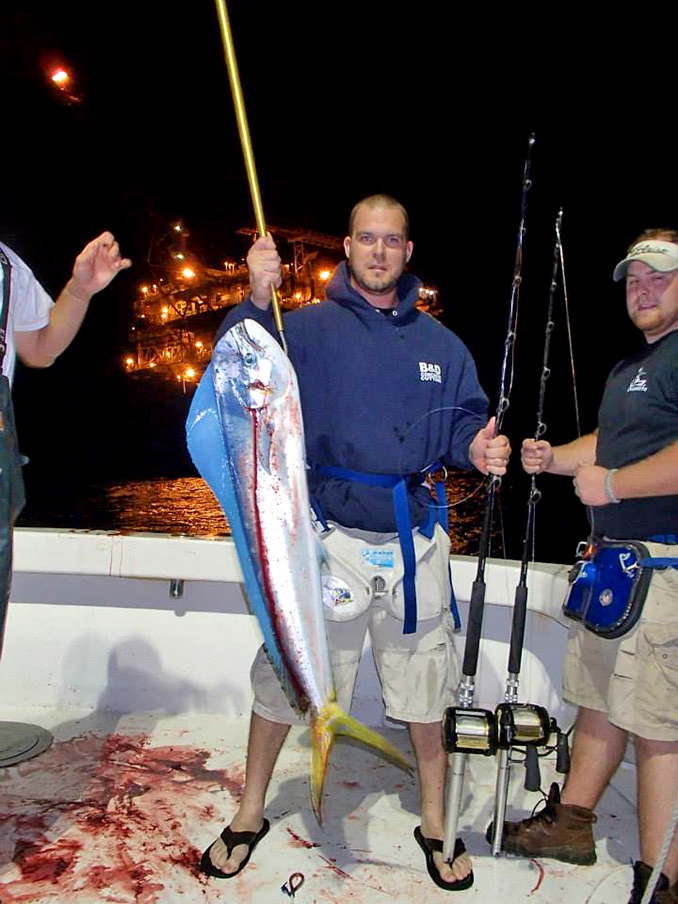
After a good ride offshore, we will start on our bottom deep sea fishing for Red Snapper , Grouper , Scamps , Vermilion Snapper and Triggerfish depending on the time of year that you go fishing. This type of offshore saltwater fishing will be done on one of the thousands of private reefs or on some natural bottom that has taken years to acquire. Usually everyone is fishing at once, and this creates a lot of fun and excitement in competing with the other sportfishermen aboard and just having a good time.
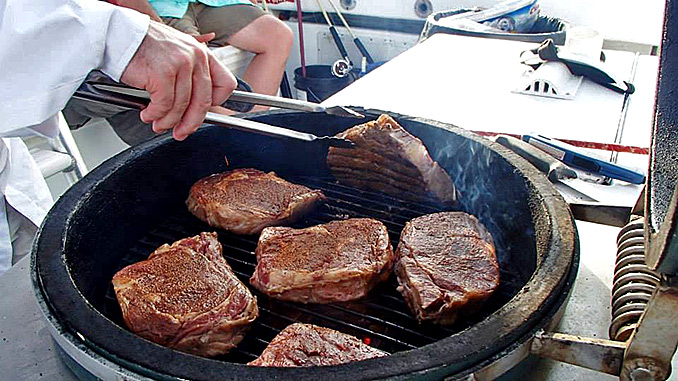
While all this is going on, it is commonplace to have your lunch smoking away on the grill . At the conclusion of the bottom fishing we will usually work our way further offshore to give everyone time to eat lunch and catch their breath to fish around some of the many oil rigs or deeper rock and chase the Amberjacks or maybe deep drop for Grouper or Tilefish. From here we can continue even further offshore to give the Tuna , Wahoo or Dolphins a shot late on the first day.
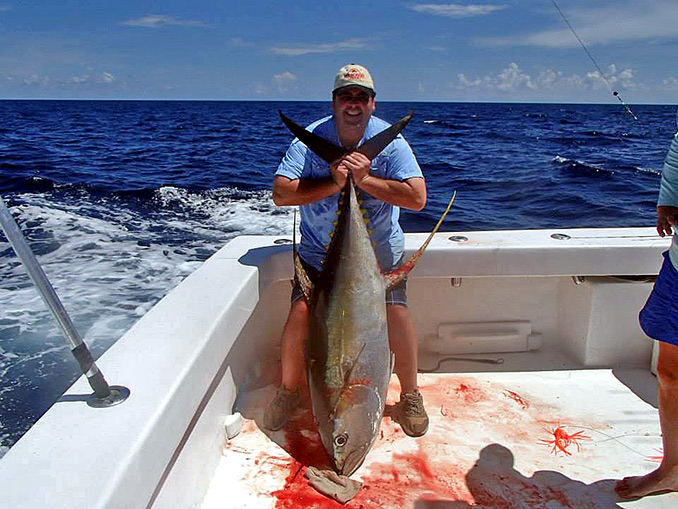
On the way offshore, we will start cooking supper and with our focus shifting to the offshore deep sea fishing for Yellow-fin Tuna , Black-Fin Tuna , Dolphin , Wahoo and the occasional Marlin .
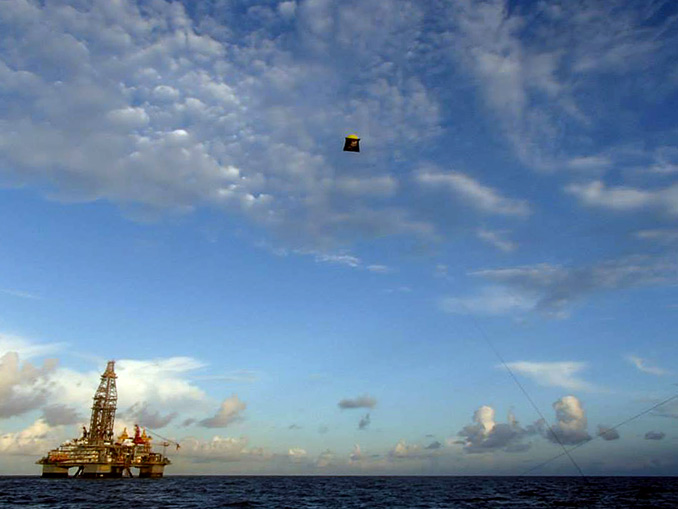
Once the offshore fishing has begun, we will employ a number of successful tactics and have three very distinct but different times for catching fish. First, is the evening bite which may be done a number of ways but Trolling or Kite fishing with live bait have proven to be the best effort for Sportfishermen in this time frame.
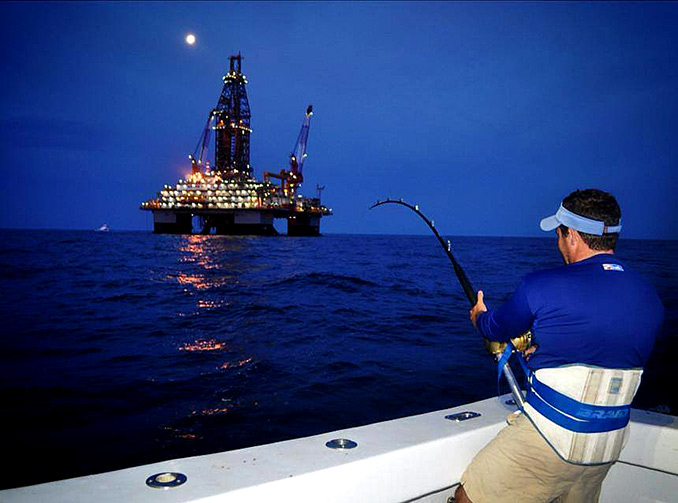
After the sun goes down and everyone is enjoying their dinners, we may try to deep sea jig some Black fin Tunas or possibly try to chum up a yellow fin right under the boat if the conditions will allow. As serious sportfishermen, it is not uncommon for us to fish well into the night. With the new water maker onboard there will be enough water for a hot shower. Early the second morning before the sun comes up, we usually try some more deep jigging and chunking for the Yellow-fin’s until right at the crack of daylight and then we may either go back to the Kite or trolling methods. As the sun comes up, it is a very exciting time to be on the deck with the anticipation of the “Big Bite” at any moment.
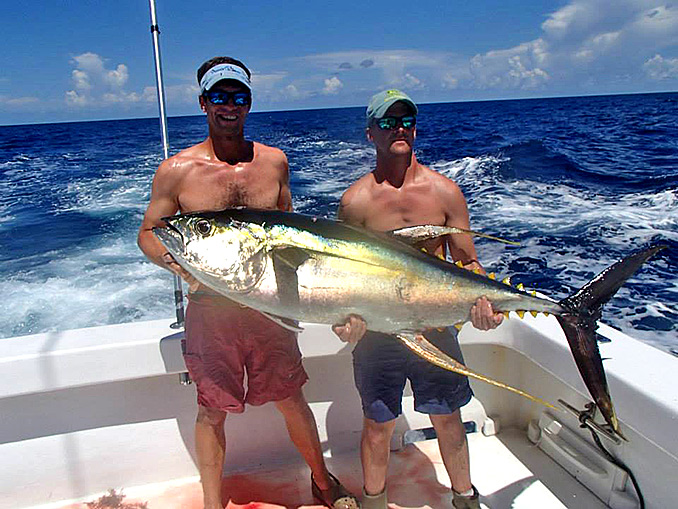
If the bite is productive we will certainly stick with it until the bite slows or it is time to head back in. This will always be our longest ride of the trip but after a very exciting offshore deep sea fishing trip and all the fun, this is when the card games and Satellite TV will come in useful. However, most people will sleep all the way to the dock. Most trips return to the dock after lunch anywhere from 12-4 pm depending on the length of the ride. Some of the trips offshore will carry you to points well offshore - some as far as 75 to 150 miles from port. No two trips are ever the same and there is always some fun and exciting things to do on a trip like this that will set it apart from others. Nowhere else will you find a camping trip, fishing trip, and picnic like this!
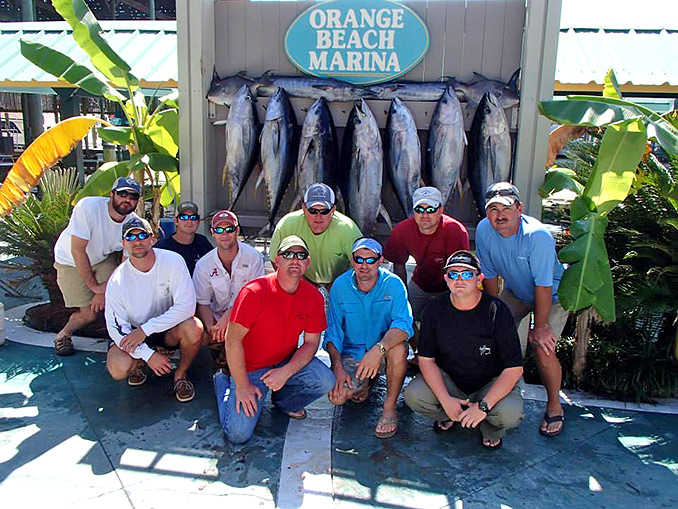
Book your Deep Sea Fishing Trip on the Intimidator Today!!!
- 4 Hour Trip
- News-Articles
FOLLOW US!
Intimidator Deep Sea Fishing Charters © 1996-2024
Join us for a Whale Watching Adventure!

- Starting in April
Overnight Fishing Trips
Quick Details
- Hour Glass Duration: 1 to 1.5 Days
- User Ages: All ages
- Tags Tour Type: Fishing
Cruise to Catalina or San Clemente Island on an Overnight Trip
Join us today for an exciting overnight fishing trip to San Clemente Island or Catalina Island (one to one-and-a-half-day trips run to the Cortez Bank, weather permitting).
On these trips, you will:
- Search for seasonal catches including yellowtail, white sea bass, calico bass, bonito, dorado, albacore, yellowfin tuna & bluefin tuna.
- Learn from our knowledgeable, friendly captain and crew who expertly guide you throughout this fun-filled excursion.
- Enjoy breathtaking views of Catalina and San Clemente Islands with their serene beaches and scenic shorelines from the deck of the Fury.
- Cool down with cold drinks and more in our full-service galley. Hungry? Both snacks and hot food are available!
- From novice to expert, everyone will enjoy discovering their love of sportfishing, conservation, and the great outdoors on this unique overnight trip.
Additional Information
- Fishing Equipment: Spinning reel rods are available to rent for and include a small tackle package.
- Fishing License Regulations: Anglers 16 years of age or older are required to have a fishing license before getting on the boat. Please pre-purchase your licenses online at https://www.ca.wildlifelicense.com/InternetSales/ .
- Food and Beverages: Our boats feature full-service cash galleys that offer beverages, snacks, and hot sandwiches for purchase.
- Gratuities: Tips for the hard-working crew members are optional but greatly appreciated! Typical tips range from $5-$10 per adult ticket.
Related Tours
- Tags Fishing
- User All ages
- Hour Glass 9 hours
3/4-Day Fishing
Fish for tuna, white sea bass, bonito, and more on our 3/4-day Dana Point fishing trip, our most popular time frame for fishing in Southern California.
- Limited Passenger Load For Your Comfort!
- Starting April
- Hour Glass 12 hours
All-Day Limited Load Fishing Trip – Fishing Catalina or Offshore
Relax and enjoy the views during a three-hour boat ride out to Catalina Island or offshore. Once we arrive, this full-day fishing trip is truly amazing! Reserve your spot online.
Multi Trip Fishing Packages
Do you have company coming into town and don’t know what day to book? No worries, we have you covered! Sport fishing and whale watching options available!
Boat Reviews
- Boats Specs
- Marine Pros
- Boat Insurance
- Boat Warranties
- Boat Transport
- Boat Towing
- Marine Forecasts

Your Ultimate Boating Resource

The Ultimate Boat Trip Checklist: Don’t Leave Anything Behind
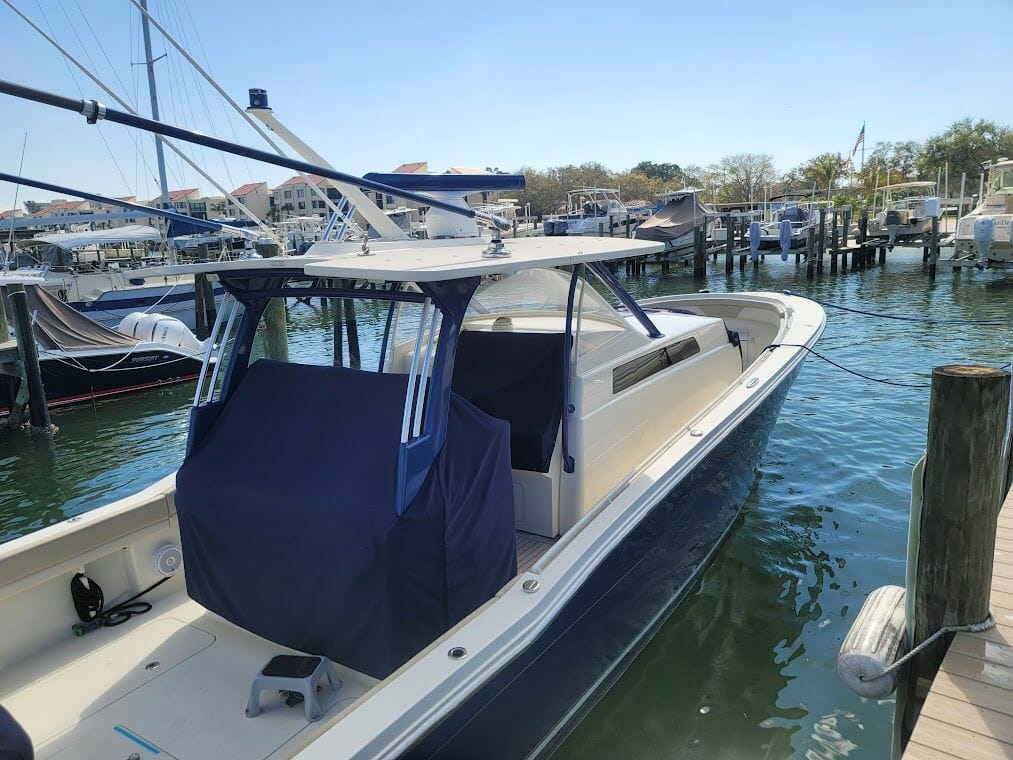
A boat trip is an excellent way to relax and enjoy the beauty of nature, and the excitement of being on the water. But to ensure your trip goes smoothly, it’s important to prepare and pack all the essentials. Making sure you have everything you need is key, so we have compiled the ultimate boat trip checklist to make sure nothing gets left behind.
Safety Equipment
It’s imperative to prioritize safety when preparing for a boat trip. The following items are essential:
- Life jackets : Ensure you have enough life jackets for every passenger, and that they fit correctly.
- Throwable flotation devices : These can be used to help rescue someone who has fallen overboard.
- Fire extinguishers : Check for expiry dates and ensure they are fully charged.
- Signal flares : Pack both handheld and aerial flares to enable communication in case of an emergency.
- First aid kit : Include bandages, gauze, antiseptic wipes, tweezers, seasickness remedies, pain relievers, and any personal medication.
- VHF radio : This is crucial for establishing communication with the coast guard, as well as other vessels.
- Whistle or air horn : These can be used to signal for help.
- Emergency position-indicating radio beacon (EPIRB): This device emits a signal that assists the coast guard in locating you during an emergency.
Navigation Tools
- GPS device : A GPS device helps with navigation, ensuring you remain on course to your destination.
- Compass : A backup option in case your GPS device malfunctions.
- Nautical charts : Another backup option for navigation; these maps show maritime features such as depth, water currents, and hazards.
- Binoculars : Useful for scouting distant landmarks.
- Depth finder : This device indicates water depth, which is essential when anchoring or avoiding shallow areas.
Boat Maintenance and Tools
Even a well-maintained boat may need minor repairs while on the water. Ensure that you pack:
- Spare engine parts : Including spark plugs, fuel filters, belts, and hoses.
- Marine tool kit : Including wrenches, pliers, screwdrivers, and a hammer.
- Duct tape and sealants : For temporary fixes on the boat.
- Spare rope, lines, and fenders: These can be used for towing, mooring, or as extra fender protection.
- Spare anchor : In case your primary anchor fails or is lost.
- Flashlight or headlamp : Useful for night time navigation or repairs.
Clothing and Personal Items
Pack clothing according to the weather conditions and expected activities. Some staples include:
- Waterproof and windproof jackets
- Insulated clothing for colder weather
- Quick-drying clothes for warmer conditions
- Swimwear and towels
- Hats, sunglasses, and sunscreen
- Personal hygiene items, including toilet paper, toothbrushes, and soap
- Insect repellent
Food and Beverages
- Freshwater: Pack enough drinking water for each person, taking into account the trip’s duration.
- Non-perishable and easy-to-prepare foods: Granola bars, instant noodles, and canned goods are some options.
- Cooler with ice or ice packs for perishable items
- Portable stove and cookware: In case you need to prepare hot meals
- Collapsible or reusable dishes, utensils, and cups
- Trash bags for waste disposal
- Snacks, beverages, and any specific dietary items
Entertainment
- Fishing gear and tackle
- Water sports equipment, such as paddleboards or snorkeling gear
- Portable speakers and electronic devices
- Board games, cards, or books
Using this ultimate boat trip checklist, you can be confident that you have all the essentials for a safe, enjoyable, and relaxing journey on the water. Remember to double-check all safety equipment, tools, and personal items before setting sail. Bon voyage!
RELATED ARTICLES
2024 pursuit os 445: an overview, boat safety 101: exploring the serenity and adventure of boating, the moment of truth – 6 signs you need a new boat, eco-savvy sailing: expert tips for reducing fuel costs and enhancing your boating experience, sea safety blueprint: constructing the perfect float plan for your boating adventures, latest posts, the top 9 reasons to maintain a meticulous boat log, don't miss, our newsletter.
Get the latest boating tips, fishing resources and featured products in your email from BoatingWorld.com!
What type of wood is used for pier pilings?
What is the difference between a dock and a floating pier, what is the proper technique for pulling a beginner wakeboarder, what does ‘no wake’ mean on a lake, what is the difference between wash and wake, 10 essential tips for fishing near private property, the benefits of using a drift sock: guidance for anglers, lure fishing: secrets for imitating live bait and attracting fish, explore the untapped depths of america’s best bass fishing spots, tackle your catch-and-release adventures with these 6 tips, outboard motor maintenance: tips for keeping your engine in top shape, the essential boat tool kit: tools every boater needs, diy boat building: 8 tips and tricks for building your own vessel, the art of miniature maritime craftsmanship: ship in a bottle, antifouling paints: a guide to keeping your boat shipshape, beginner’s guide to standup paddle boarding: tips and techniques, boating for fitness: how to stay active on the water, kayak safety: how to stay safe on the water, anchoring in a kayak or canoe: how to secure your small boat, 2024 aquila 47 molokai review, 2024 sea-doo switch 13 sport review, 2024 aspen c120 review, 2024 yamaha 222xd review, 2024 sailfish 316 dc review, 2023 seavee 340z review, 2023 centurion fi23 review, gear reviews, megabass oneten max lbo jerkbait review, fortress anchors fx-7 anchoring system review, fortress anchors fx-11 anchoring system review, fortress anchors commando anchor kit review, fortress anchors aluminum anchors review, stay in touch.
To be updated with all the latest news, offers and special announcements.
- Privacy Policy

- How To Fish & Boat
- Register Your Boat
- Get Your Fishing License
- Places To Boat And Fish
- Connecticut
- District Of Columbia
- Massachusetts
- Mississippi
- New Hampshire
- North Carolina
- North Dakota
- Pennsylvania
- Rhode Island
- South Carolina
- South Dakota
- West Virginia
- How to Catch Fish
- How to Tie Fishing Knots
- Fishing Gear and Tackle
- How to Fish with Lures
- How to Fish with Live Bait
- Fishing Safety
- Fishing Tips
- When to Fish
- Types of Fishing
- Fishing and Conservation
- Fishing Resources
- When to Saltwater Fish
- Saltwater Bait and Lures
- Saltwater Fishing Tackle
- Types of Saltwater Fishing
- Saltwater Fishing Gear
- Saltwater Fish Species
- Types of Freshwater Fishing
- When to Freshwater Fish
- Freshwater Bait and Lures
- Best Freshwater Fishing Gear
- Fly Fishing Basics
- Fly Fishing Flies
- Fly Fishing Gear
- Fly Casting
- Ice Fishing Basics
- Ice Fishing Gear
- Ice Fishing Techniques
- Boating Basics
- How to Boat
- Boating and Water Safety
- Choose Your Boat
- Use Our Boat Explorer Tool
- Get on the Water
The Ice Fishing Essentials Checklist
By Ed Hitchcock
Feb 22, 2020
Use the ice fishing essentials checklist to map out the must have, need to have, and good to have ice fishing gear
Ice fishing is an awesome way for anglers to access a body of water without owning a boat. You can get out on the ice and fish areas not reachable from shore with a short list of “must have” ice fishing gear. If you want to catch fish consistently throughout the season, there is a slightly longer list that includes “need to have” ice fishing gear. Lastly, if you want to step your game up and fish like the pro’s, you should invest in the “good to have” elite ice gear. Here is a checklist of the must have, need to have, and good to have ice fishing essentials.
Strong Winter Clothing: Jacket, snowpants, hats, boots, gloves
Safety Picks: Emergency ice picks to climb out of the water
Ice Cleats: Metal spikes worn on boots to walk on ice
Ice Auger: 6-10 Inch ice drill to cut holes in the ice
Ice Scoop: Ladle to remove slush from your hole
Ice Rod & Reel: Smaller rod & reel to fish over an ice hole
Micro Jigs: Small jigs to fish your bait
Spikes: Wax worms or euro larvae to use as bait
Need to Have
Jigging Lures: Ice fishing lures that sink to target larger game fish
Ice Spoons: Light reflecting lures to target larger eating fish
Tip Up: Ice fishing trap with live bait to spread out for trophy fish
Minnows: Bait to tip your jigging lures or use live under your tip up
Bucket: Storage for your gear and a stool to sit on
Sled: Transports your ice fishing gear long distances
Good to Have
Power Auger: automatic ice auger that drills holes for you
Flasher: Fish finder to locate fish and present your lure
Underwater Camera: Used to find panfish and identify bottom consistency
Shelter: Pop-up or flip-over shelter to fish in poor weather conditions
Portable Heater: Heat source to fish at night in your shelter
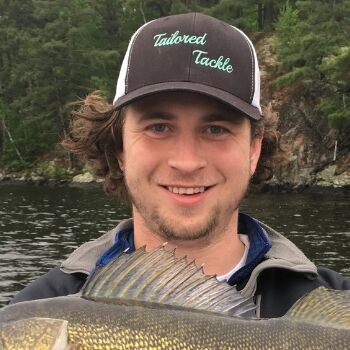
NEWSWAVES SIGNUP
Stay up-to-date on RBFF’s fishing and boating programs and initiatives with the monthly NewsWaves newsletter. Read about relevant stories on the fishing and boating industry, RBFF’s work to and increase participation, the latest research and trends on fishing and boating audiences and participation and marketing insights, tips and content.
Please complete the following fields to subscribe to our newsletter.
Download this Resource
To download this free resource, please fill out the form below:

IMAGES
VIDEO
COMMENTS
Rod and Reel Setups. 20lb Setup - The first setup you will want to bring aboard any overnight or multi-day trip is a lighter 20-pound live bait setup. When stopping on kelp paddies or schools of tuna, this setup is frequently grabbed from the rack to fly line live sardines for football size yellowfin, smaller yellowtail, and dorado.
Lay the packet (s) directly on the coals, fish side down first. Time the cooking for 8 minutes (10 if you think the coals are not quite hot enough). Flip the packets and cook for another 8-10 minutes. Place the packets on a plate and open CAREFULLY…. watch the hot steam. Serve with crusty sourdough bread, and enjoy!
Personalized deals just for you. Shop at Academy Sports + Outdoors the way you want with an experience just for you. Create an account. Shop Academy Sports + Outdoors for sporting goods, hunting, fishing and camping equipment. Find recreation and leisure products, footwear, apparel, grills, bikes, g...
Checking forecasts and knowing seasonal weather patterns for the area that you plan to fish can make or break your day. Another key consideration would be the species that you plan to target. If you are planning a multi-species trip, a variety of rods, reels, and fly boxes may be required. Researching the location you plan to fish and types of ...
9. Pants. Pants will provide you with more protection against insects and the sun than a pair of shorts. Find pants in a lightweight, moisture-wicking or breathable materials. 10. Hat. Add a wide-brimmed hat to your fishing trip packing list so that you can use it to keep your face shielded from the sun. 11.
Tackle is the equipment that is attached to the end of your line. The basic tackle you should have on your checklist includes bait, lures, hooks, swivels, bobbers, and weights. Your choice of live bait or artificial lures will depend on where you're fishing and what you hope to catch. Research beforehand, or ask for help at the local tackle ...
We know the story. You've saved your vacation dates, booked your flight, and are about to go on the trip of a lifetime. You've chosen a superb, fully equipped fishing charter and are all set to land the fish of your dreams. Your plane leaves tomorrow and it couldn't reach its destination soon enough. There's just one tiny hitch.
Especially for those of us who wish to enjoy a resource on the landscape (specifically, healthy fish populations), it's vital to know how to treat it. 6. Cater your style of fishing. A final thing to keep in mind if you're going on an overnight backcountry trip is that you may want to try a different style of fishing than you normally use.
This is the standard stuff I wear and bring with me on every trip. What I wear: tshirt, fishing shorts, hoodie, hat, sunglasses and my Xtra Tuff boots (with AFTCO Fishing Feet inside). Other stuff I always bring: camera, sunscreen (I like 50+ for my face, ears and neck), lip balm with SPF, fishing towel, water, snacks (salty favorites include: beef jerky, clif bars, fruit - especially apples)
2 Packing the Right Gear. The first step to getting prepared for fishing is assembling and packing all the gear you might need for the whole trip. You will need to carry normal belongings like sunscreen to effective baits like mealworms to make your preparation complete. Make sure to begin gathering everything as early as possible so that your ...
Thermos or large water bottle. A thermos or water bottle with a guarantee that your beverage will stay cool for long periods of time is perfect for a fishing trip. Sandwiches. Pack your favorite! But remember, hand sanitizer is your friend. Beverages. A cold, hydrating beverage that is perfect for a day at sea.
The clear blue and purple water of the wide-open Gulf of Mexico showed the flashing deep-water prisms that tell an angler that the shallow waters of the coast are far away. On this overnight fishing trip, there's no line of coast on the horizon and the small craft have been left far behind. The only thing other than water and sky that can be ...
Hiking shoes & sandals. Hat (s) (Fleece, sun) Toiletries kit (tooth brush, toothpaste, deodorant, sunscreen, lotion, tweezers, nail clippers, etc.) Personal first aid (ibuprofen, bandaids, anti-diuretics, etc) Camp Games. Speaker. Books. General check list for overnight & multiday river trips in rafts, kayaks & canoes. Gear packing list ...
Cut down on hook injuries and make your fishing experience easier with a Hook-Eze: a tool that holds the hook in place while you tie the knot. It can trim the fishing line, remove the hook from the fish's mouth, and even cover the hook during travel. The less time you spend fussing over getting the perfect knot, the more time you can spend ...
3. Neck Wallet. I bring this on all of my international fishing trips. Sometimes, in order to get to the best fishing spots, it's necessary to travel through dangerous areas. In order to protect my most important belongings from pickpockets, I keep my passport, cash, credit cards, and keys in my HERO Neck Wallet.
There's never been a better time to book a deep-sea fishing trip. To help you prepare for the adventure, we've created this checklist of 20 essential items that you should always carry. Rods, reels and bait are provided by the charter service, but there's more than just fishing tackle required for a memorable offshore experience.
Fare: $329.00+Rod and Reel $25.00=$354.00+ tax $24.78=$378.78. 39 hr. Overnight Trip Meal Package: $35.00 + 2.45 (tax) + 6.30 (18%gratuity) = $43.75 ea. Includes 2 Dinners, 4 Sandwiches breakfast and Lunch, 4 Chips, 4 Candy or Granola Bars, 8 Sodas and unlimited Water (excluding beer) By purchasing the meal packages for your group. the beer ...
By packing the right fishing gear, you'll be well-prepared for a successful Canadian fishing trip. Don't forget to double-check your packing list before you leave, and happy fishing! Bring Warm Clothes and Rain Gear. When you're planning a fishing trip, it's important to consider the weather conditions of your destination.
We specialize in overnight trips, but offer trips to 3 days for the ones who just cannot get enough offshore deep sea fishing. A typical overnighter usually leaves the dock about 6 am. Most of the overnight trips that we run are combo bottom / offshore deep sea fishing trips. We will start the day in some cases doing some live bait fishing.
Gratuities: Tips for the hard-working crew members are optional but greatly appreciated! Typical tips range from $5-$10 per adult ticket. Cruise to Catalina Island or San Clemente Island on an exciting overnight fishing trip. Hook bluefin tuna, calico bass, dorado, and more. Book online now!
Pack clothing according to the weather conditions and expected activities. Some staples include: Waterproof and windproof jackets. Insulated clothing for colder weather. Quick-drying clothes for warmer conditions. Swimwear and towels. Hats, sunglasses, and sunscreen. Personal hygiene items, including toilet paper, toothbrushes, and soap.
Need to Have. Jigging Lures: Ice fishing lures that sink to target larger game fish. Ice Spoons: Light reflecting lures to target larger eating fish. Tip Up: Ice fishing trap with live bait to spread out for trophy fish. Minnows: Bait to tip your jigging lures or use live under your tip up. Bucket: Storage for your gear and a stool to sit on.